Strategic Plan for Broadstairs Coastal Area Tourism and Marketing
VerifiedAdded on 2022/12/12
|20
|4848
|199
Report
AI Summary
This report provides a detailed analysis of the tourism strategic planning for the Broadstairs coastal area. It begins with an introduction to tourism strategic planning and its importance for competition and service delivery, highlighting collaborative planning as a key trend. The report then explores the benefits of producing tourism strategic plans for coastal areas, including sustainable resource use, destination marketing strategies, community integration, stakeholder involvement, economic improvement, and the meeting of tourist needs, with examples from Sicily and Croatia. The importance of collaborative planning is discussed, along with its pros and cons. Finally, the report compiles a brief tourism strategy for Broadstairs, including vision, objectives, key areas of focus, marketing research, and destination assessment, addressing current issues and challenges faced by the area. The report emphasizes the need for marketing, collaboration, and sustainable practices to improve the tourism sector in the Broadstairs coastal area.
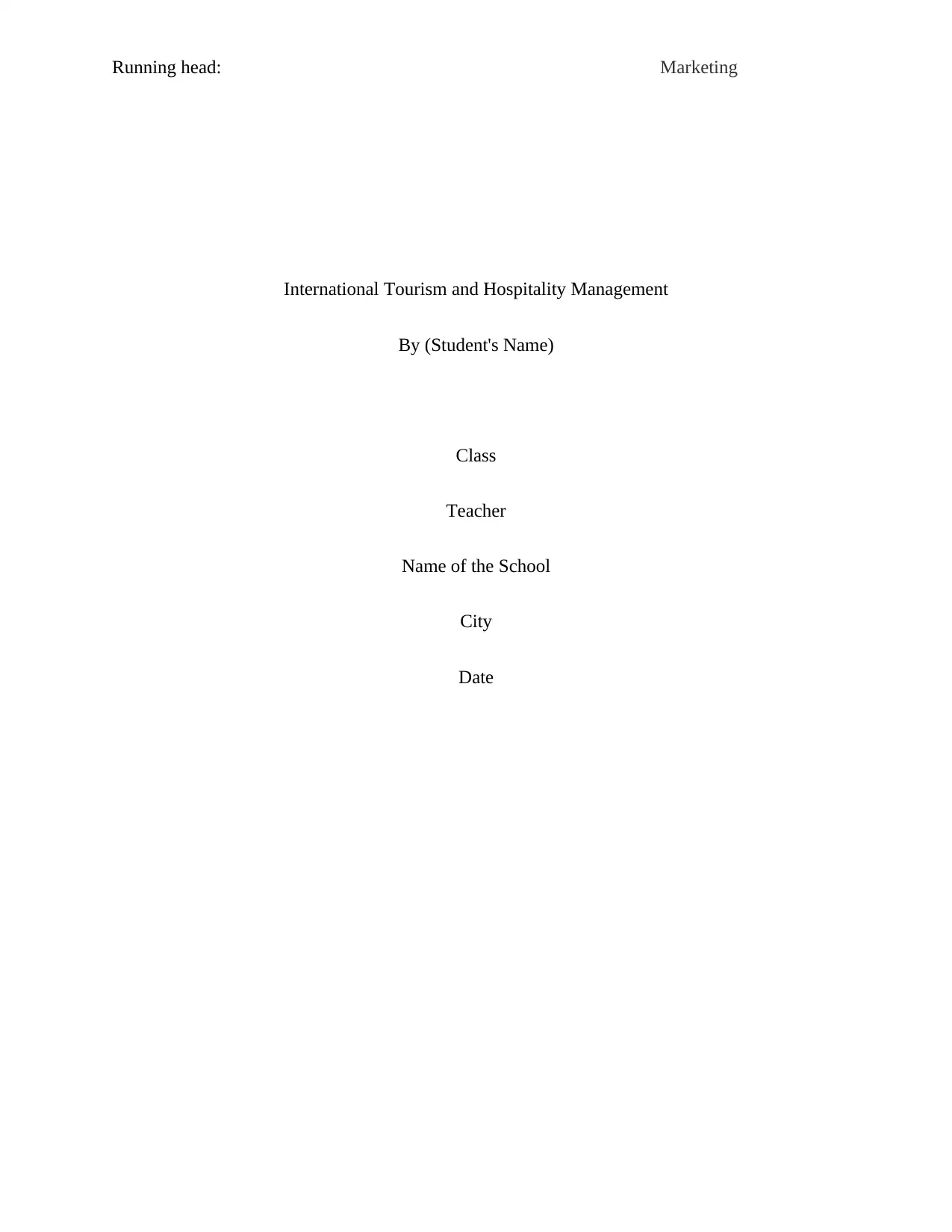
Running head: Marketing
International Tourism and Hospitality Management
By (Student's Name)
Class
Teacher
Name of the School
City
Date
International Tourism and Hospitality Management
By (Student's Name)
Class
Teacher
Name of the School
City
Date
Paraphrase This Document
Need a fresh take? Get an instant paraphrase of this document with our AI Paraphraser
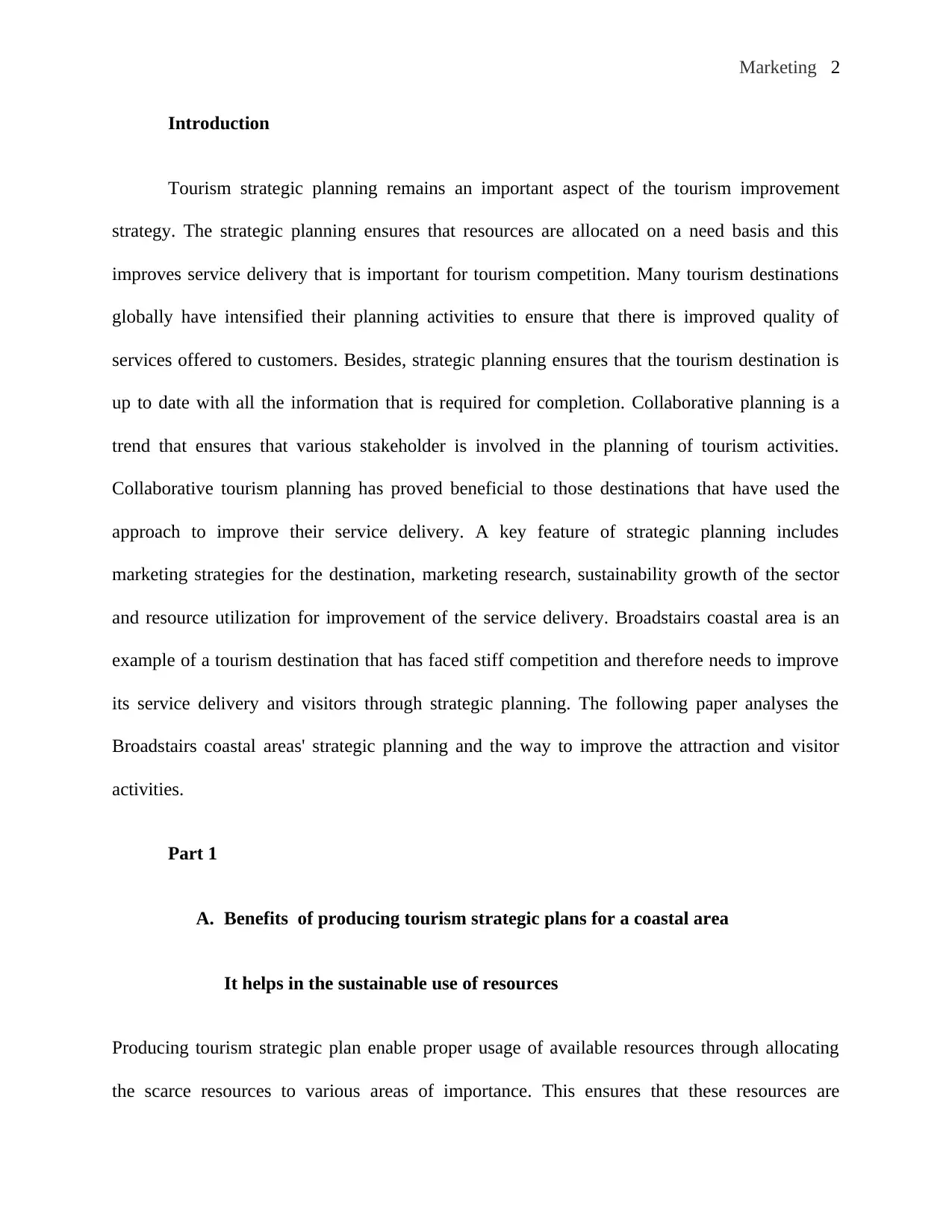
Marketing 2
Introduction
Tourism strategic planning remains an important aspect of the tourism improvement
strategy. The strategic planning ensures that resources are allocated on a need basis and this
improves service delivery that is important for tourism competition. Many tourism destinations
globally have intensified their planning activities to ensure that there is improved quality of
services offered to customers. Besides, strategic planning ensures that the tourism destination is
up to date with all the information that is required for completion. Collaborative planning is a
trend that ensures that various stakeholder is involved in the planning of tourism activities.
Collaborative tourism planning has proved beneficial to those destinations that have used the
approach to improve their service delivery. A key feature of strategic planning includes
marketing strategies for the destination, marketing research, sustainability growth of the sector
and resource utilization for improvement of the service delivery. Broadstairs coastal area is an
example of a tourism destination that has faced stiff competition and therefore needs to improve
its service delivery and visitors through strategic planning. The following paper analyses the
Broadstairs coastal areas' strategic planning and the way to improve the attraction and visitor
activities.
Part 1
A. Benefits of producing tourism strategic plans for a coastal area
It helps in the sustainable use of resources
Producing tourism strategic plan enable proper usage of available resources through allocating
the scarce resources to various areas of importance. This ensures that these resources are
Introduction
Tourism strategic planning remains an important aspect of the tourism improvement
strategy. The strategic planning ensures that resources are allocated on a need basis and this
improves service delivery that is important for tourism competition. Many tourism destinations
globally have intensified their planning activities to ensure that there is improved quality of
services offered to customers. Besides, strategic planning ensures that the tourism destination is
up to date with all the information that is required for completion. Collaborative planning is a
trend that ensures that various stakeholder is involved in the planning of tourism activities.
Collaborative tourism planning has proved beneficial to those destinations that have used the
approach to improve their service delivery. A key feature of strategic planning includes
marketing strategies for the destination, marketing research, sustainability growth of the sector
and resource utilization for improvement of the service delivery. Broadstairs coastal area is an
example of a tourism destination that has faced stiff competition and therefore needs to improve
its service delivery and visitors through strategic planning. The following paper analyses the
Broadstairs coastal areas' strategic planning and the way to improve the attraction and visitor
activities.
Part 1
A. Benefits of producing tourism strategic plans for a coastal area
It helps in the sustainable use of resources
Producing tourism strategic plan enable proper usage of available resources through allocating
the scarce resources to various areas of importance. This ensures that these resources are
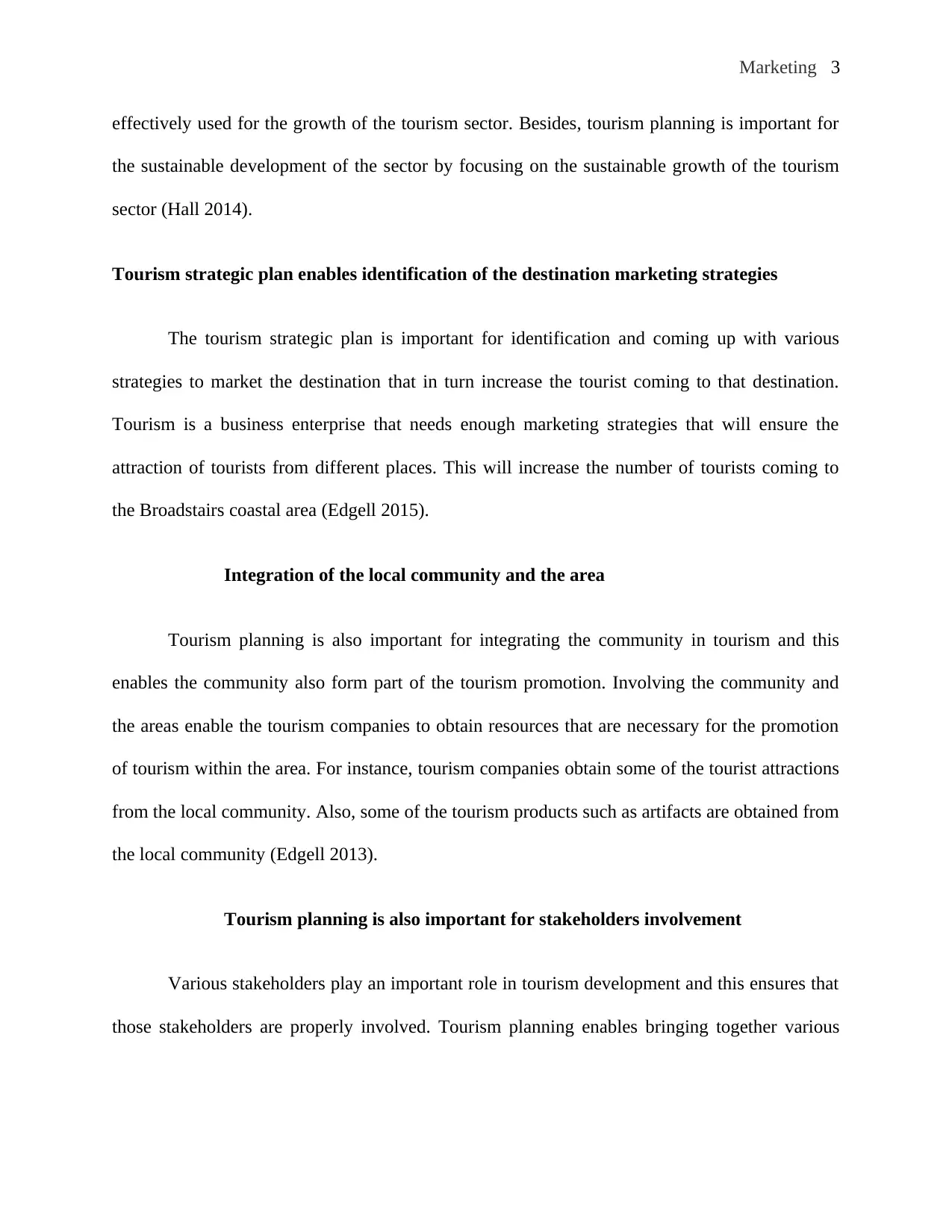
Marketing 3
effectively used for the growth of the tourism sector. Besides, tourism planning is important for
the sustainable development of the sector by focusing on the sustainable growth of the tourism
sector (Hall 2014).
Tourism strategic plan enables identification of the destination marketing strategies
The tourism strategic plan is important for identification and coming up with various
strategies to market the destination that in turn increase the tourist coming to that destination.
Tourism is a business enterprise that needs enough marketing strategies that will ensure the
attraction of tourists from different places. This will increase the number of tourists coming to
the Broadstairs coastal area (Edgell 2015).
Integration of the local community and the area
Tourism planning is also important for integrating the community in tourism and this
enables the community also form part of the tourism promotion. Involving the community and
the areas enable the tourism companies to obtain resources that are necessary for the promotion
of tourism within the area. For instance, tourism companies obtain some of the tourist attractions
from the local community. Also, some of the tourism products such as artifacts are obtained from
the local community (Edgell 2013).
Tourism planning is also important for stakeholders involvement
Various stakeholders play an important role in tourism development and this ensures that
those stakeholders are properly involved. Tourism planning enables bringing together various
effectively used for the growth of the tourism sector. Besides, tourism planning is important for
the sustainable development of the sector by focusing on the sustainable growth of the tourism
sector (Hall 2014).
Tourism strategic plan enables identification of the destination marketing strategies
The tourism strategic plan is important for identification and coming up with various
strategies to market the destination that in turn increase the tourist coming to that destination.
Tourism is a business enterprise that needs enough marketing strategies that will ensure the
attraction of tourists from different places. This will increase the number of tourists coming to
the Broadstairs coastal area (Edgell 2015).
Integration of the local community and the area
Tourism planning is also important for integrating the community in tourism and this
enables the community also form part of the tourism promotion. Involving the community and
the areas enable the tourism companies to obtain resources that are necessary for the promotion
of tourism within the area. For instance, tourism companies obtain some of the tourist attractions
from the local community. Also, some of the tourism products such as artifacts are obtained from
the local community (Edgell 2013).
Tourism planning is also important for stakeholders involvement
Various stakeholders play an important role in tourism development and this ensures that
those stakeholders are properly involved. Tourism planning enables bringing together various
You're viewing a preview
Unlock full access by subscribing today!
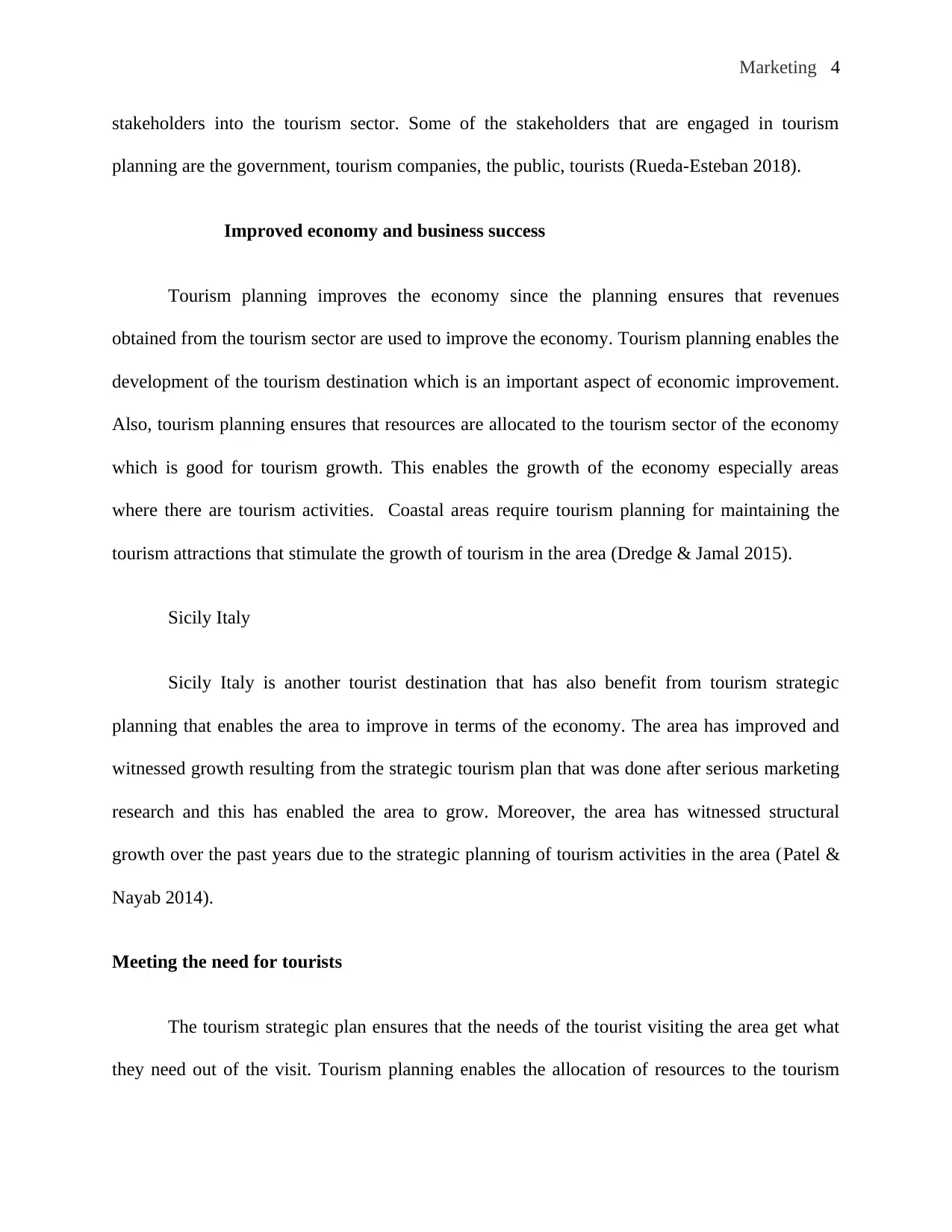
Marketing 4
stakeholders into the tourism sector. Some of the stakeholders that are engaged in tourism
planning are the government, tourism companies, the public, tourists (Rueda-Esteban 2018).
Improved economy and business success
Tourism planning improves the economy since the planning ensures that revenues
obtained from the tourism sector are used to improve the economy. Tourism planning enables the
development of the tourism destination which is an important aspect of economic improvement.
Also, tourism planning ensures that resources are allocated to the tourism sector of the economy
which is good for tourism growth. This enables the growth of the economy especially areas
where there are tourism activities. Coastal areas require tourism planning for maintaining the
tourism attractions that stimulate the growth of tourism in the area (Dredge & Jamal 2015).
Sicily Italy
Sicily Italy is another tourist destination that has also benefit from tourism strategic
planning that enables the area to improve in terms of the economy. The area has improved and
witnessed growth resulting from the strategic tourism plan that was done after serious marketing
research and this has enabled the area to grow. Moreover, the area has witnessed structural
growth over the past years due to the strategic planning of tourism activities in the area (Patel &
Nayab 2014).
Meeting the need for tourists
The tourism strategic plan ensures that the needs of the tourist visiting the area get what
they need out of the visit. Tourism planning enables the allocation of resources to the tourism
stakeholders into the tourism sector. Some of the stakeholders that are engaged in tourism
planning are the government, tourism companies, the public, tourists (Rueda-Esteban 2018).
Improved economy and business success
Tourism planning improves the economy since the planning ensures that revenues
obtained from the tourism sector are used to improve the economy. Tourism planning enables the
development of the tourism destination which is an important aspect of economic improvement.
Also, tourism planning ensures that resources are allocated to the tourism sector of the economy
which is good for tourism growth. This enables the growth of the economy especially areas
where there are tourism activities. Coastal areas require tourism planning for maintaining the
tourism attractions that stimulate the growth of tourism in the area (Dredge & Jamal 2015).
Sicily Italy
Sicily Italy is another tourist destination that has also benefit from tourism strategic
planning that enables the area to improve in terms of the economy. The area has improved and
witnessed growth resulting from the strategic tourism plan that was done after serious marketing
research and this has enabled the area to grow. Moreover, the area has witnessed structural
growth over the past years due to the strategic planning of tourism activities in the area (Patel &
Nayab 2014).
Meeting the need for tourists
The tourism strategic plan ensures that the needs of the tourist visiting the area get what
they need out of the visit. Tourism planning enables the allocation of resources to the tourism
Paraphrase This Document
Need a fresh take? Get an instant paraphrase of this document with our AI Paraphraser
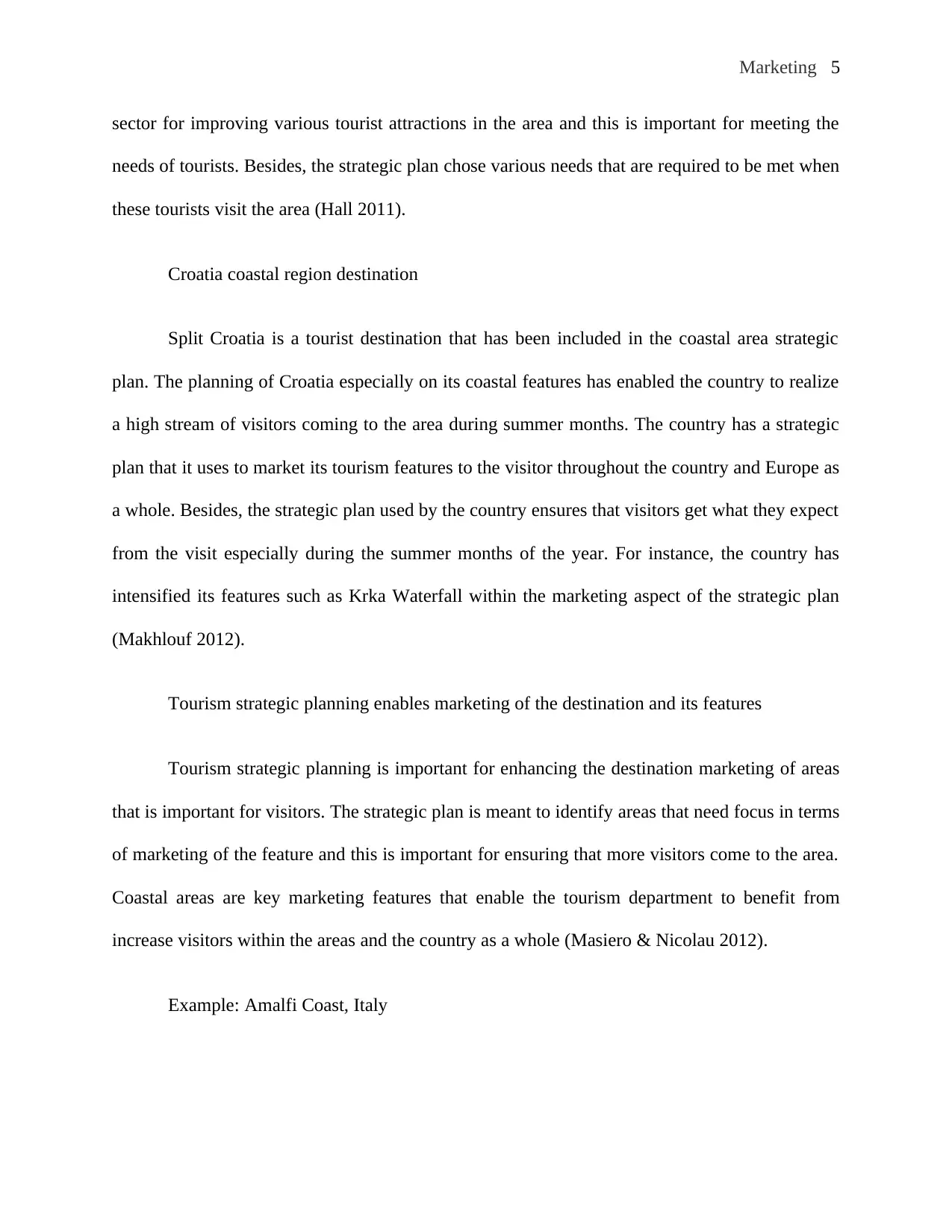
Marketing 5
sector for improving various tourist attractions in the area and this is important for meeting the
needs of tourists. Besides, the strategic plan chose various needs that are required to be met when
these tourists visit the area (Hall 2011).
Croatia coastal region destination
Split Croatia is a tourist destination that has been included in the coastal area strategic
plan. The planning of Croatia especially on its coastal features has enabled the country to realize
a high stream of visitors coming to the area during summer months. The country has a strategic
plan that it uses to market its tourism features to the visitor throughout the country and Europe as
a whole. Besides, the strategic plan used by the country ensures that visitors get what they expect
from the visit especially during the summer months of the year. For instance, the country has
intensified its features such as Krka Waterfall within the marketing aspect of the strategic plan
(Makhlouf 2012).
Tourism strategic planning enables marketing of the destination and its features
Tourism strategic planning is important for enhancing the destination marketing of areas
that is important for visitors. The strategic plan is meant to identify areas that need focus in terms
of marketing of the feature and this is important for ensuring that more visitors come to the area.
Coastal areas are key marketing features that enable the tourism department to benefit from
increase visitors within the areas and the country as a whole (Masiero & Nicolau 2012).
Example: Amalfi Coast, Italy
sector for improving various tourist attractions in the area and this is important for meeting the
needs of tourists. Besides, the strategic plan chose various needs that are required to be met when
these tourists visit the area (Hall 2011).
Croatia coastal region destination
Split Croatia is a tourist destination that has been included in the coastal area strategic
plan. The planning of Croatia especially on its coastal features has enabled the country to realize
a high stream of visitors coming to the area during summer months. The country has a strategic
plan that it uses to market its tourism features to the visitor throughout the country and Europe as
a whole. Besides, the strategic plan used by the country ensures that visitors get what they expect
from the visit especially during the summer months of the year. For instance, the country has
intensified its features such as Krka Waterfall within the marketing aspect of the strategic plan
(Makhlouf 2012).
Tourism strategic planning enables marketing of the destination and its features
Tourism strategic planning is important for enhancing the destination marketing of areas
that is important for visitors. The strategic plan is meant to identify areas that need focus in terms
of marketing of the feature and this is important for ensuring that more visitors come to the area.
Coastal areas are key marketing features that enable the tourism department to benefit from
increase visitors within the areas and the country as a whole (Masiero & Nicolau 2012).
Example: Amalfi Coast, Italy
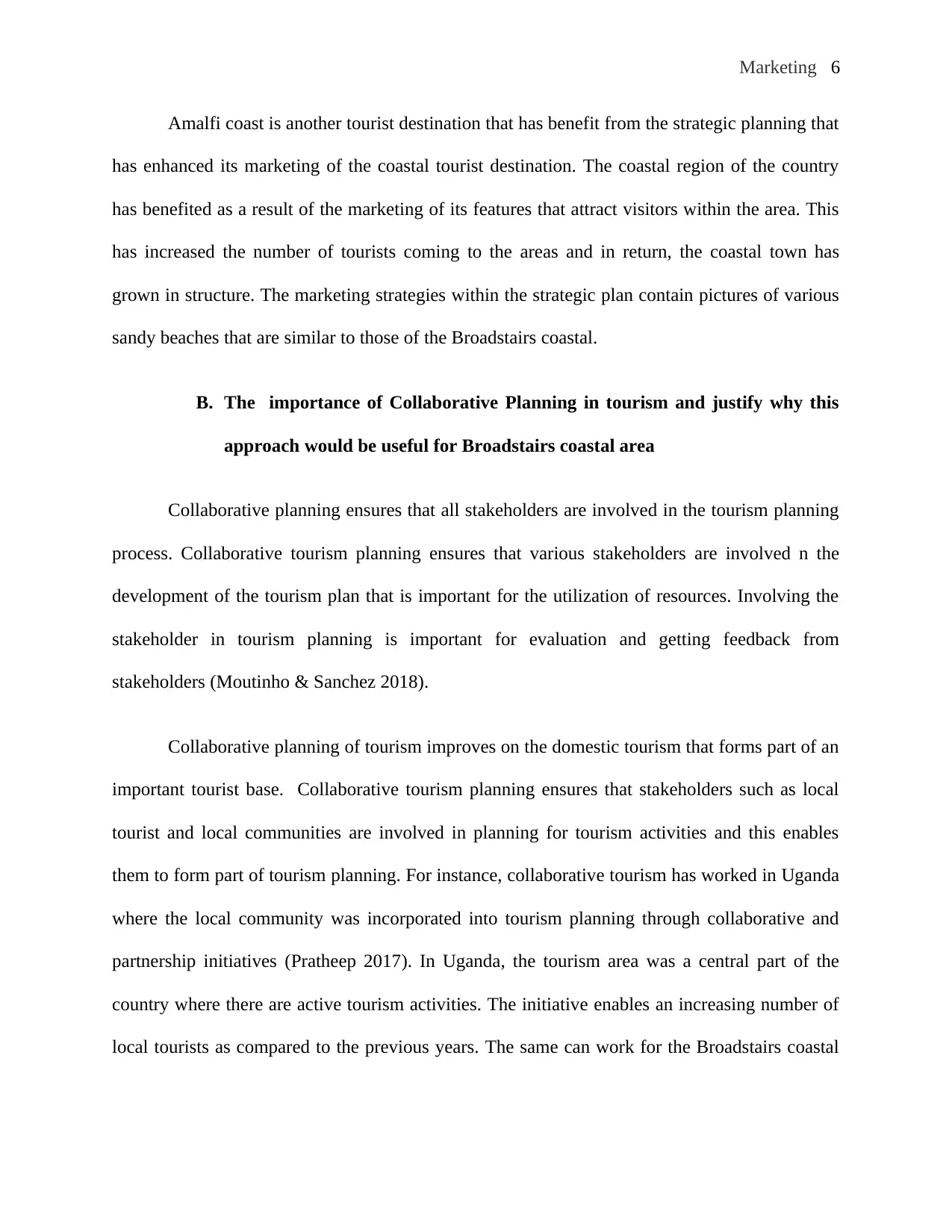
Marketing 6
Amalfi coast is another tourist destination that has benefit from the strategic planning that
has enhanced its marketing of the coastal tourist destination. The coastal region of the country
has benefited as a result of the marketing of its features that attract visitors within the area. This
has increased the number of tourists coming to the areas and in return, the coastal town has
grown in structure. The marketing strategies within the strategic plan contain pictures of various
sandy beaches that are similar to those of the Broadstairs coastal.
B. The importance of Collaborative Planning in tourism and justify why this
approach would be useful for Broadstairs coastal area
Collaborative planning ensures that all stakeholders are involved in the tourism planning
process. Collaborative tourism planning ensures that various stakeholders are involved n the
development of the tourism plan that is important for the utilization of resources. Involving the
stakeholder in tourism planning is important for evaluation and getting feedback from
stakeholders (Moutinho & Sanchez 2018).
Collaborative planning of tourism improves on the domestic tourism that forms part of an
important tourist base. Collaborative tourism planning ensures that stakeholders such as local
tourist and local communities are involved in planning for tourism activities and this enables
them to form part of tourism planning. For instance, collaborative tourism has worked in Uganda
where the local community was incorporated into tourism planning through collaborative and
partnership initiatives (Pratheep 2017). In Uganda, the tourism area was a central part of the
country where there are active tourism activities. The initiative enables an increasing number of
local tourists as compared to the previous years. The same can work for the Broadstairs coastal
Amalfi coast is another tourist destination that has benefit from the strategic planning that
has enhanced its marketing of the coastal tourist destination. The coastal region of the country
has benefited as a result of the marketing of its features that attract visitors within the area. This
has increased the number of tourists coming to the areas and in return, the coastal town has
grown in structure. The marketing strategies within the strategic plan contain pictures of various
sandy beaches that are similar to those of the Broadstairs coastal.
B. The importance of Collaborative Planning in tourism and justify why this
approach would be useful for Broadstairs coastal area
Collaborative planning ensures that all stakeholders are involved in the tourism planning
process. Collaborative tourism planning ensures that various stakeholders are involved n the
development of the tourism plan that is important for the utilization of resources. Involving the
stakeholder in tourism planning is important for evaluation and getting feedback from
stakeholders (Moutinho & Sanchez 2018).
Collaborative planning of tourism improves on the domestic tourism that forms part of an
important tourist base. Collaborative tourism planning ensures that stakeholders such as local
tourist and local communities are involved in planning for tourism activities and this enables
them to form part of tourism planning. For instance, collaborative tourism has worked in Uganda
where the local community was incorporated into tourism planning through collaborative and
partnership initiatives (Pratheep 2017). In Uganda, the tourism area was a central part of the
country where there are active tourism activities. The initiative enables an increasing number of
local tourists as compared to the previous years. The same can work for the Broadstairs coastal
You're viewing a preview
Unlock full access by subscribing today!
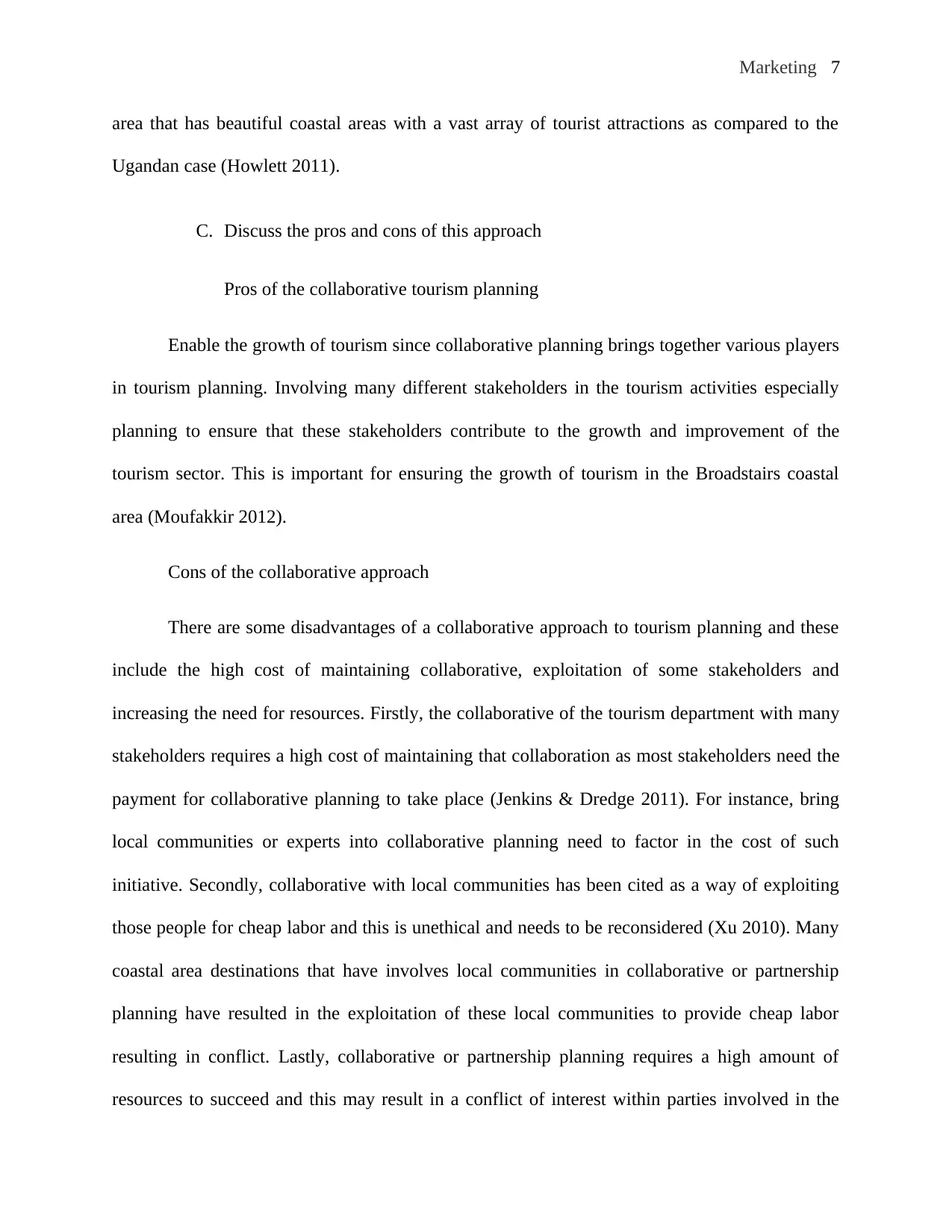
Marketing 7
area that has beautiful coastal areas with a vast array of tourist attractions as compared to the
Ugandan case (Howlett 2011).
C. Discuss the pros and cons of this approach
Pros of the collaborative tourism planning
Enable the growth of tourism since collaborative planning brings together various players
in tourism planning. Involving many different stakeholders in the tourism activities especially
planning to ensure that these stakeholders contribute to the growth and improvement of the
tourism sector. This is important for ensuring the growth of tourism in the Broadstairs coastal
area (Moufakkir 2012).
Cons of the collaborative approach
There are some disadvantages of a collaborative approach to tourism planning and these
include the high cost of maintaining collaborative, exploitation of some stakeholders and
increasing the need for resources. Firstly, the collaborative of the tourism department with many
stakeholders requires a high cost of maintaining that collaboration as most stakeholders need the
payment for collaborative planning to take place (Jenkins & Dredge 2011). For instance, bring
local communities or experts into collaborative planning need to factor in the cost of such
initiative. Secondly, collaborative with local communities has been cited as a way of exploiting
those people for cheap labor and this is unethical and needs to be reconsidered (Xu 2010). Many
coastal area destinations that have involves local communities in collaborative or partnership
planning have resulted in the exploitation of these local communities to provide cheap labor
resulting in conflict. Lastly, collaborative or partnership planning requires a high amount of
resources to succeed and this may result in a conflict of interest within parties involved in the
area that has beautiful coastal areas with a vast array of tourist attractions as compared to the
Ugandan case (Howlett 2011).
C. Discuss the pros and cons of this approach
Pros of the collaborative tourism planning
Enable the growth of tourism since collaborative planning brings together various players
in tourism planning. Involving many different stakeholders in the tourism activities especially
planning to ensure that these stakeholders contribute to the growth and improvement of the
tourism sector. This is important for ensuring the growth of tourism in the Broadstairs coastal
area (Moufakkir 2012).
Cons of the collaborative approach
There are some disadvantages of a collaborative approach to tourism planning and these
include the high cost of maintaining collaborative, exploitation of some stakeholders and
increasing the need for resources. Firstly, the collaborative of the tourism department with many
stakeholders requires a high cost of maintaining that collaboration as most stakeholders need the
payment for collaborative planning to take place (Jenkins & Dredge 2011). For instance, bring
local communities or experts into collaborative planning need to factor in the cost of such
initiative. Secondly, collaborative with local communities has been cited as a way of exploiting
those people for cheap labor and this is unethical and needs to be reconsidered (Xu 2010). Many
coastal area destinations that have involves local communities in collaborative or partnership
planning have resulted in the exploitation of these local communities to provide cheap labor
resulting in conflict. Lastly, collaborative or partnership planning requires a high amount of
resources to succeed and this may result in a conflict of interest within parties involved in the
Paraphrase This Document
Need a fresh take? Get an instant paraphrase of this document with our AI Paraphraser
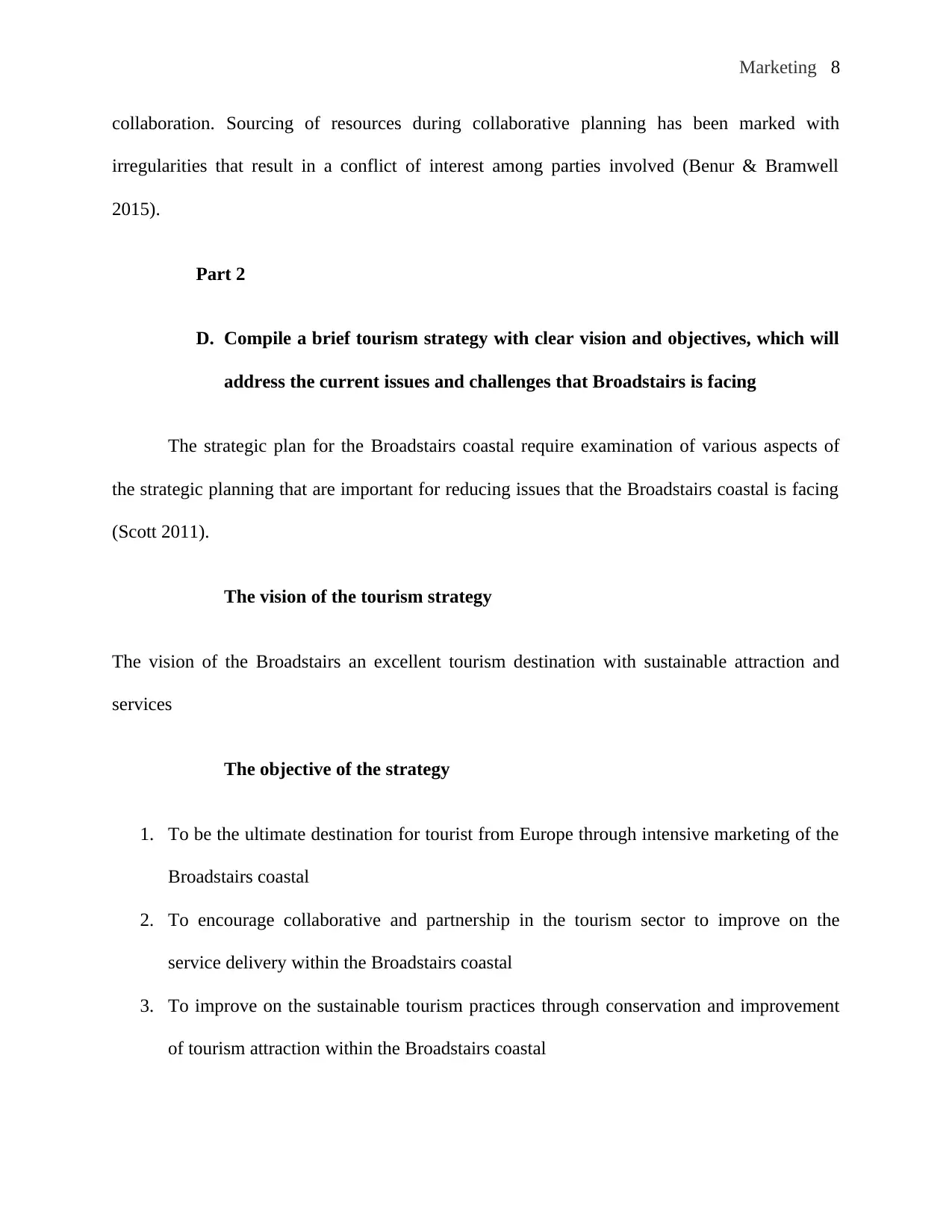
Marketing 8
collaboration. Sourcing of resources during collaborative planning has been marked with
irregularities that result in a conflict of interest among parties involved (Benur & Bramwell
2015).
Part 2
D. Compile a brief tourism strategy with clear vision and objectives, which will
address the current issues and challenges that Broadstairs is facing
The strategic plan for the Broadstairs coastal require examination of various aspects of
the strategic planning that are important for reducing issues that the Broadstairs coastal is facing
(Scott 2011).
The vision of the tourism strategy
The vision of the Broadstairs an excellent tourism destination with sustainable attraction and
services
The objective of the strategy
1. To be the ultimate destination for tourist from Europe through intensive marketing of the
Broadstairs coastal
2. To encourage collaborative and partnership in the tourism sector to improve on the
service delivery within the Broadstairs coastal
3. To improve on the sustainable tourism practices through conservation and improvement
of tourism attraction within the Broadstairs coastal
collaboration. Sourcing of resources during collaborative planning has been marked with
irregularities that result in a conflict of interest among parties involved (Benur & Bramwell
2015).
Part 2
D. Compile a brief tourism strategy with clear vision and objectives, which will
address the current issues and challenges that Broadstairs is facing
The strategic plan for the Broadstairs coastal require examination of various aspects of
the strategic planning that are important for reducing issues that the Broadstairs coastal is facing
(Scott 2011).
The vision of the tourism strategy
The vision of the Broadstairs an excellent tourism destination with sustainable attraction and
services
The objective of the strategy
1. To be the ultimate destination for tourist from Europe through intensive marketing of the
Broadstairs coastal
2. To encourage collaborative and partnership in the tourism sector to improve on the
service delivery within the Broadstairs coastal
3. To improve on the sustainable tourism practices through conservation and improvement
of tourism attraction within the Broadstairs coastal
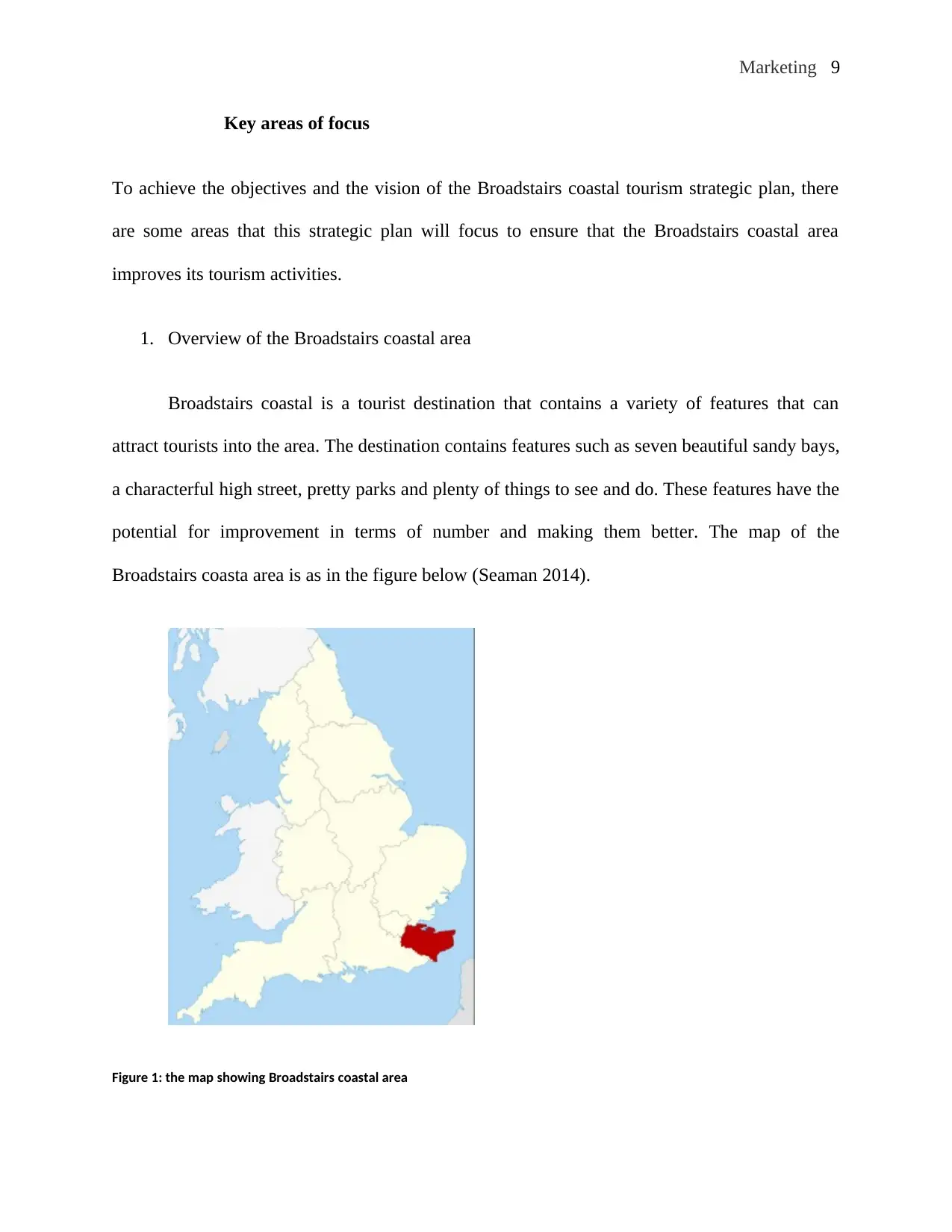
Marketing 9
Key areas of focus
To achieve the objectives and the vision of the Broadstairs coastal tourism strategic plan, there
are some areas that this strategic plan will focus to ensure that the Broadstairs coastal area
improves its tourism activities.
1. Overview of the Broadstairs coastal area
Broadstairs coastal is a tourist destination that contains a variety of features that can
attract tourists into the area. The destination contains features such as seven beautiful sandy bays,
a characterful high street, pretty parks and plenty of things to see and do. These features have the
potential for improvement in terms of number and making them better. The map of the
Broadstairs coasta area is as in the figure below (Seaman 2014).
Figure 1: the map showing Broadstairs coastal area
Key areas of focus
To achieve the objectives and the vision of the Broadstairs coastal tourism strategic plan, there
are some areas that this strategic plan will focus to ensure that the Broadstairs coastal area
improves its tourism activities.
1. Overview of the Broadstairs coastal area
Broadstairs coastal is a tourist destination that contains a variety of features that can
attract tourists into the area. The destination contains features such as seven beautiful sandy bays,
a characterful high street, pretty parks and plenty of things to see and do. These features have the
potential for improvement in terms of number and making them better. The map of the
Broadstairs coasta area is as in the figure below (Seaman 2014).
Figure 1: the map showing Broadstairs coastal area
You're viewing a preview
Unlock full access by subscribing today!
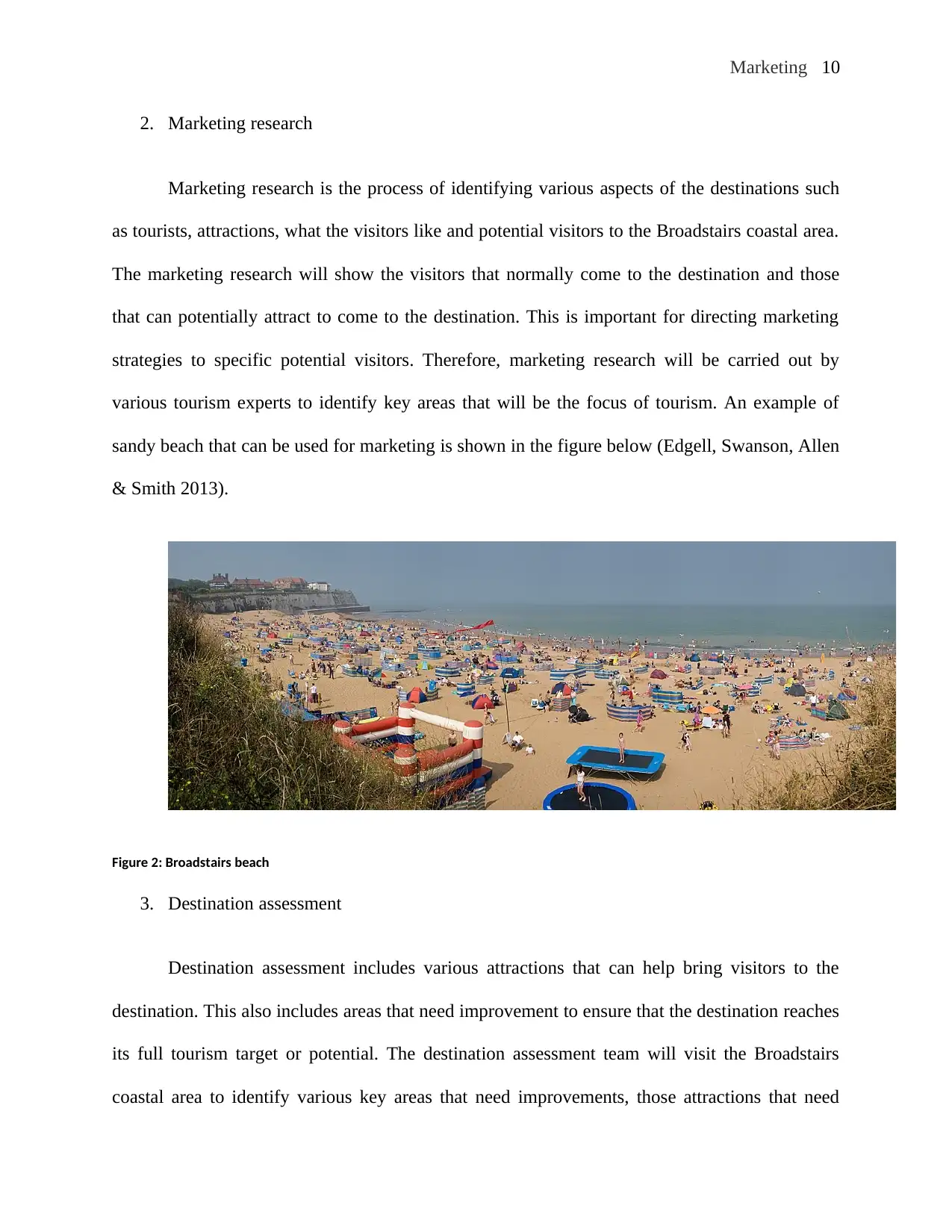
Marketing 10
2. Marketing research
Marketing research is the process of identifying various aspects of the destinations such
as tourists, attractions, what the visitors like and potential visitors to the Broadstairs coastal area.
The marketing research will show the visitors that normally come to the destination and those
that can potentially attract to come to the destination. This is important for directing marketing
strategies to specific potential visitors. Therefore, marketing research will be carried out by
various tourism experts to identify key areas that will be the focus of tourism. An example of
sandy beach that can be used for marketing is shown in the figure below (Edgell, Swanson, Allen
& Smith 2013).
Figure 2: Broadstairs beach
3. Destination assessment
Destination assessment includes various attractions that can help bring visitors to the
destination. This also includes areas that need improvement to ensure that the destination reaches
its full tourism target or potential. The destination assessment team will visit the Broadstairs
coastal area to identify various key areas that need improvements, those attractions that need
2. Marketing research
Marketing research is the process of identifying various aspects of the destinations such
as tourists, attractions, what the visitors like and potential visitors to the Broadstairs coastal area.
The marketing research will show the visitors that normally come to the destination and those
that can potentially attract to come to the destination. This is important for directing marketing
strategies to specific potential visitors. Therefore, marketing research will be carried out by
various tourism experts to identify key areas that will be the focus of tourism. An example of
sandy beach that can be used for marketing is shown in the figure below (Edgell, Swanson, Allen
& Smith 2013).
Figure 2: Broadstairs beach
3. Destination assessment
Destination assessment includes various attractions that can help bring visitors to the
destination. This also includes areas that need improvement to ensure that the destination reaches
its full tourism target or potential. The destination assessment team will visit the Broadstairs
coastal area to identify various key areas that need improvements, those attractions that need
Paraphrase This Document
Need a fresh take? Get an instant paraphrase of this document with our AI Paraphraser
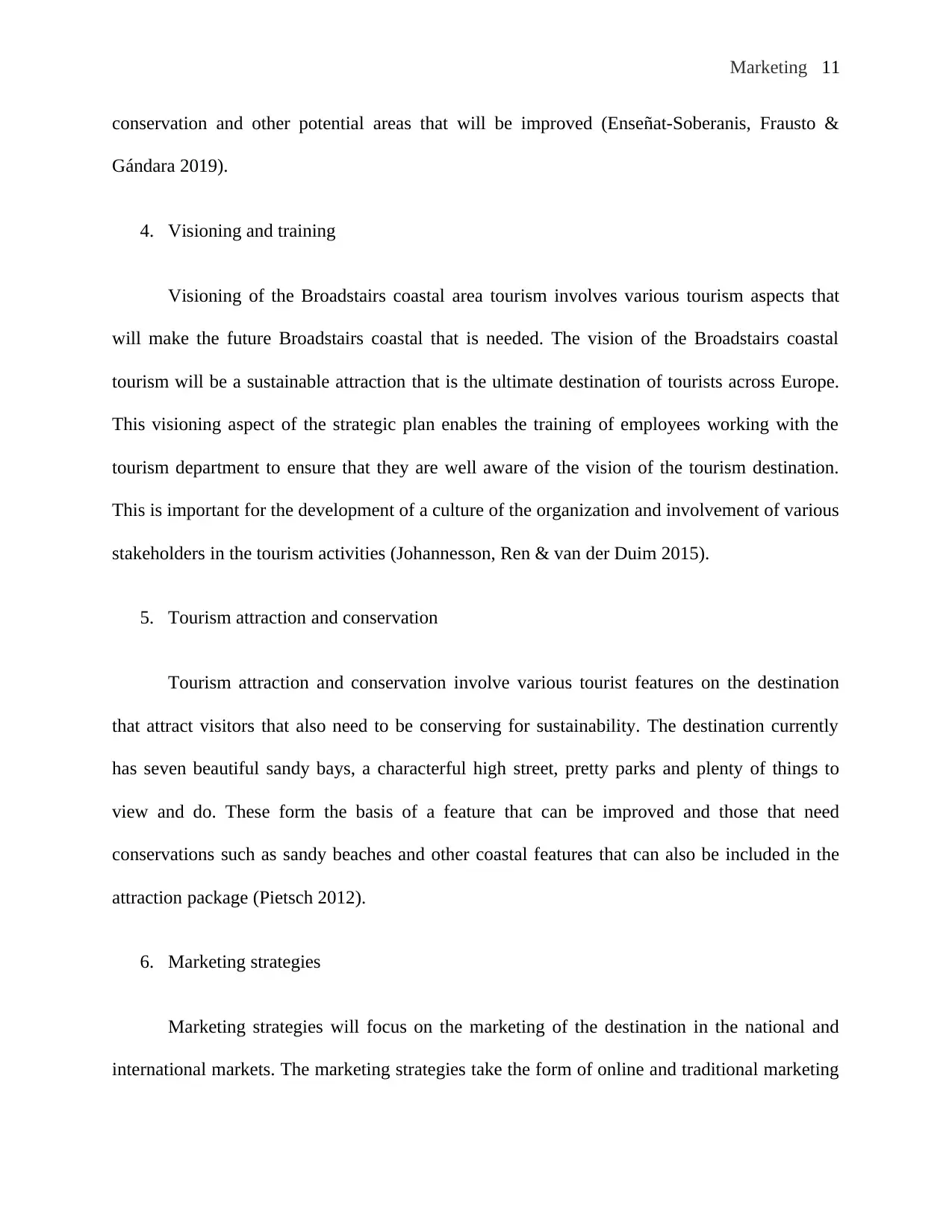
Marketing 11
conservation and other potential areas that will be improved (Enseñat-Soberanis, Frausto &
Gándara 2019).
4. Visioning and training
Visioning of the Broadstairs coastal area tourism involves various tourism aspects that
will make the future Broadstairs coastal that is needed. The vision of the Broadstairs coastal
tourism will be a sustainable attraction that is the ultimate destination of tourists across Europe.
This visioning aspect of the strategic plan enables the training of employees working with the
tourism department to ensure that they are well aware of the vision of the tourism destination.
This is important for the development of a culture of the organization and involvement of various
stakeholders in the tourism activities (Johannesson, Ren & van der Duim 2015).
5. Tourism attraction and conservation
Tourism attraction and conservation involve various tourist features on the destination
that attract visitors that also need to be conserving for sustainability. The destination currently
has seven beautiful sandy bays, a characterful high street, pretty parks and plenty of things to
view and do. These form the basis of a feature that can be improved and those that need
conservations such as sandy beaches and other coastal features that can also be included in the
attraction package (Pietsch 2012).
6. Marketing strategies
Marketing strategies will focus on the marketing of the destination in the national and
international markets. The marketing strategies take the form of online and traditional marketing
conservation and other potential areas that will be improved (Enseñat-Soberanis, Frausto &
Gándara 2019).
4. Visioning and training
Visioning of the Broadstairs coastal area tourism involves various tourism aspects that
will make the future Broadstairs coastal that is needed. The vision of the Broadstairs coastal
tourism will be a sustainable attraction that is the ultimate destination of tourists across Europe.
This visioning aspect of the strategic plan enables the training of employees working with the
tourism department to ensure that they are well aware of the vision of the tourism destination.
This is important for the development of a culture of the organization and involvement of various
stakeholders in the tourism activities (Johannesson, Ren & van der Duim 2015).
5. Tourism attraction and conservation
Tourism attraction and conservation involve various tourist features on the destination
that attract visitors that also need to be conserving for sustainability. The destination currently
has seven beautiful sandy bays, a characterful high street, pretty parks and plenty of things to
view and do. These form the basis of a feature that can be improved and those that need
conservations such as sandy beaches and other coastal features that can also be included in the
attraction package (Pietsch 2012).
6. Marketing strategies
Marketing strategies will focus on the marketing of the destination in the national and
international markets. The marketing strategies take the form of online and traditional marketing
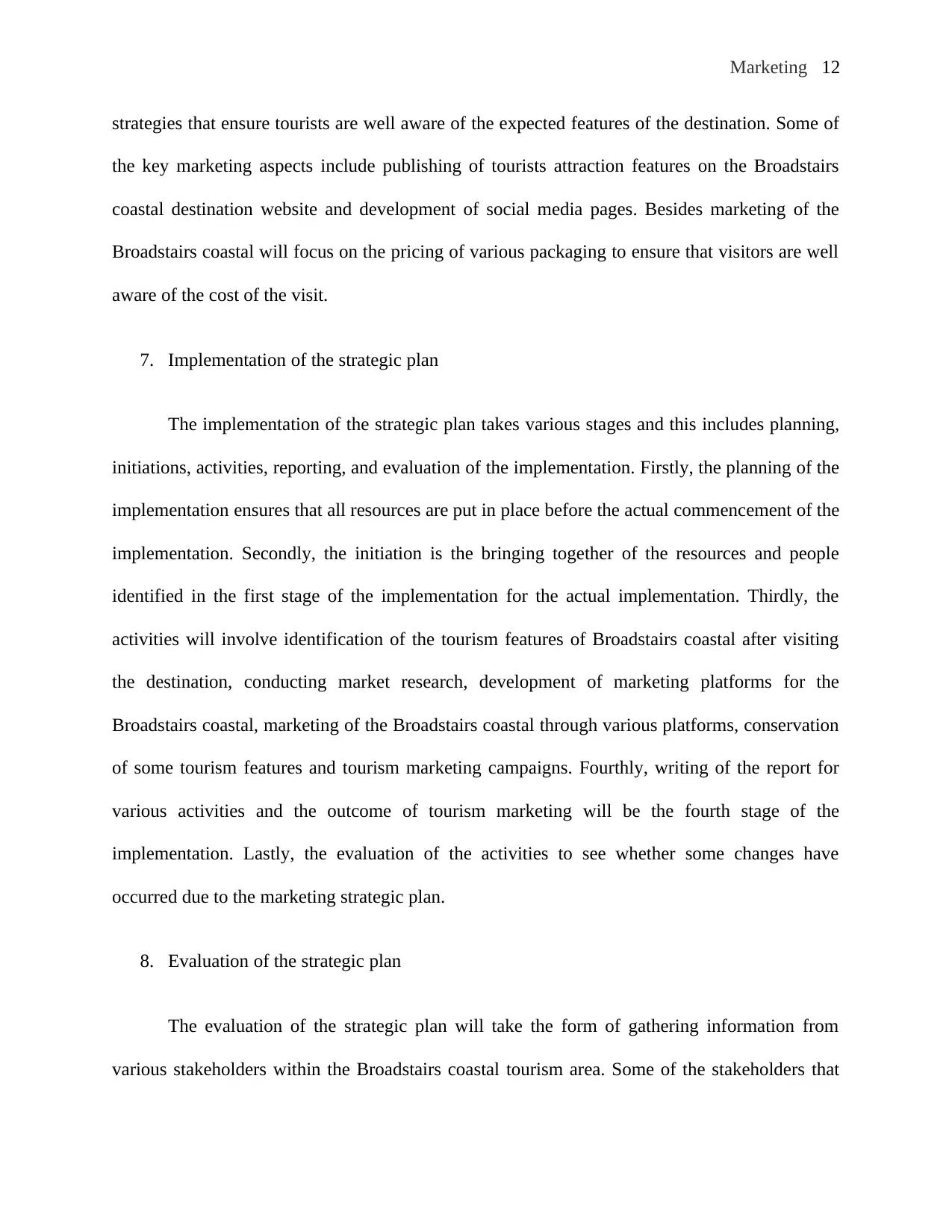
Marketing 12
strategies that ensure tourists are well aware of the expected features of the destination. Some of
the key marketing aspects include publishing of tourists attraction features on the Broadstairs
coastal destination website and development of social media pages. Besides marketing of the
Broadstairs coastal will focus on the pricing of various packaging to ensure that visitors are well
aware of the cost of the visit.
7. Implementation of the strategic plan
The implementation of the strategic plan takes various stages and this includes planning,
initiations, activities, reporting, and evaluation of the implementation. Firstly, the planning of the
implementation ensures that all resources are put in place before the actual commencement of the
implementation. Secondly, the initiation is the bringing together of the resources and people
identified in the first stage of the implementation for the actual implementation. Thirdly, the
activities will involve identification of the tourism features of Broadstairs coastal after visiting
the destination, conducting market research, development of marketing platforms for the
Broadstairs coastal, marketing of the Broadstairs coastal through various platforms, conservation
of some tourism features and tourism marketing campaigns. Fourthly, writing of the report for
various activities and the outcome of tourism marketing will be the fourth stage of the
implementation. Lastly, the evaluation of the activities to see whether some changes have
occurred due to the marketing strategic plan.
8. Evaluation of the strategic plan
The evaluation of the strategic plan will take the form of gathering information from
various stakeholders within the Broadstairs coastal tourism area. Some of the stakeholders that
strategies that ensure tourists are well aware of the expected features of the destination. Some of
the key marketing aspects include publishing of tourists attraction features on the Broadstairs
coastal destination website and development of social media pages. Besides marketing of the
Broadstairs coastal will focus on the pricing of various packaging to ensure that visitors are well
aware of the cost of the visit.
7. Implementation of the strategic plan
The implementation of the strategic plan takes various stages and this includes planning,
initiations, activities, reporting, and evaluation of the implementation. Firstly, the planning of the
implementation ensures that all resources are put in place before the actual commencement of the
implementation. Secondly, the initiation is the bringing together of the resources and people
identified in the first stage of the implementation for the actual implementation. Thirdly, the
activities will involve identification of the tourism features of Broadstairs coastal after visiting
the destination, conducting market research, development of marketing platforms for the
Broadstairs coastal, marketing of the Broadstairs coastal through various platforms, conservation
of some tourism features and tourism marketing campaigns. Fourthly, writing of the report for
various activities and the outcome of tourism marketing will be the fourth stage of the
implementation. Lastly, the evaluation of the activities to see whether some changes have
occurred due to the marketing strategic plan.
8. Evaluation of the strategic plan
The evaluation of the strategic plan will take the form of gathering information from
various stakeholders within the Broadstairs coastal tourism area. Some of the stakeholders that
You're viewing a preview
Unlock full access by subscribing today!
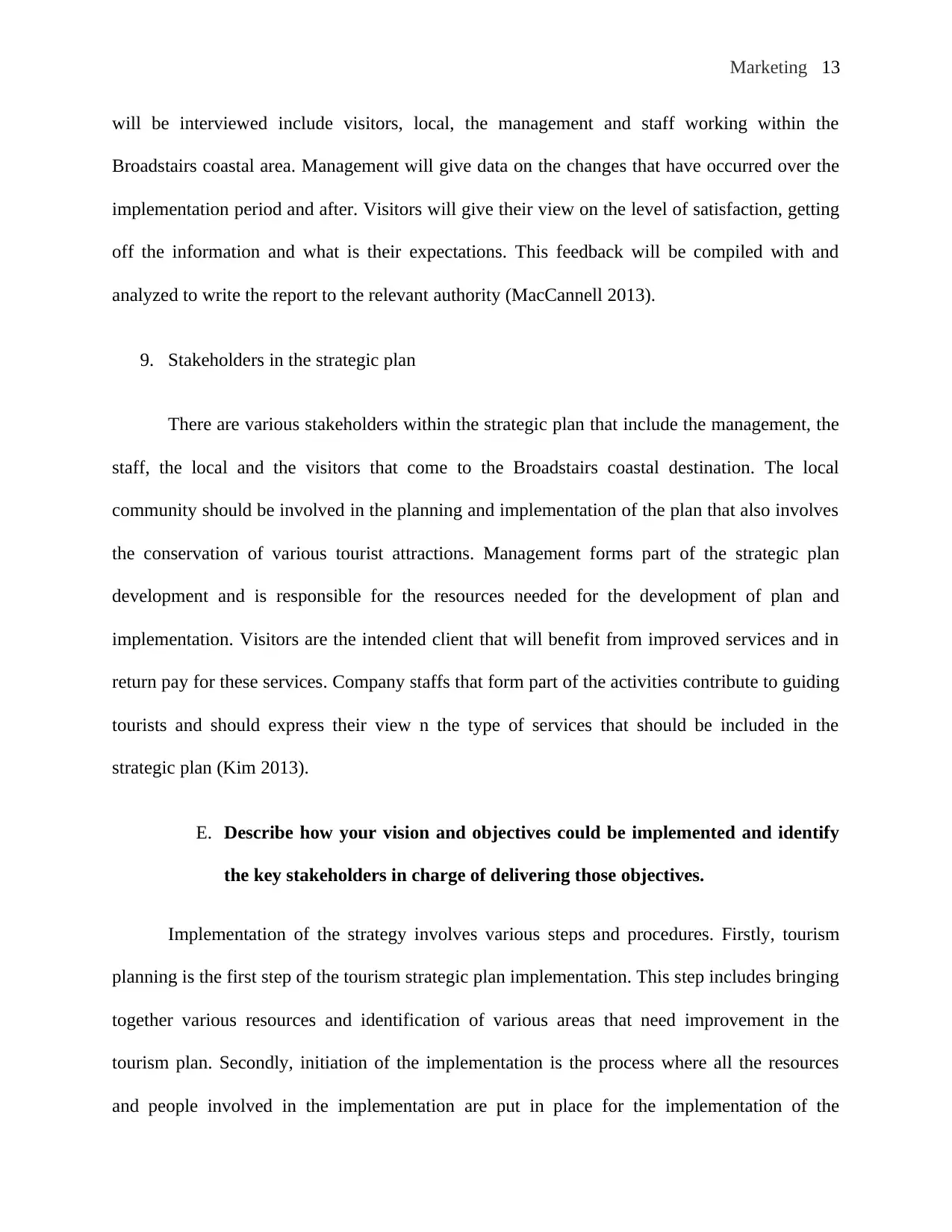
Marketing 13
will be interviewed include visitors, local, the management and staff working within the
Broadstairs coastal area. Management will give data on the changes that have occurred over the
implementation period and after. Visitors will give their view on the level of satisfaction, getting
off the information and what is their expectations. This feedback will be compiled with and
analyzed to write the report to the relevant authority (MacCannell 2013).
9. Stakeholders in the strategic plan
There are various stakeholders within the strategic plan that include the management, the
staff, the local and the visitors that come to the Broadstairs coastal destination. The local
community should be involved in the planning and implementation of the plan that also involves
the conservation of various tourist attractions. Management forms part of the strategic plan
development and is responsible for the resources needed for the development of plan and
implementation. Visitors are the intended client that will benefit from improved services and in
return pay for these services. Company staffs that form part of the activities contribute to guiding
tourists and should express their view n the type of services that should be included in the
strategic plan (Kim 2013).
E. Describe how your vision and objectives could be implemented and identify
the key stakeholders in charge of delivering those objectives.
Implementation of the strategy involves various steps and procedures. Firstly, tourism
planning is the first step of the tourism strategic plan implementation. This step includes bringing
together various resources and identification of various areas that need improvement in the
tourism plan. Secondly, initiation of the implementation is the process where all the resources
and people involved in the implementation are put in place for the implementation of the
will be interviewed include visitors, local, the management and staff working within the
Broadstairs coastal area. Management will give data on the changes that have occurred over the
implementation period and after. Visitors will give their view on the level of satisfaction, getting
off the information and what is their expectations. This feedback will be compiled with and
analyzed to write the report to the relevant authority (MacCannell 2013).
9. Stakeholders in the strategic plan
There are various stakeholders within the strategic plan that include the management, the
staff, the local and the visitors that come to the Broadstairs coastal destination. The local
community should be involved in the planning and implementation of the plan that also involves
the conservation of various tourist attractions. Management forms part of the strategic plan
development and is responsible for the resources needed for the development of plan and
implementation. Visitors are the intended client that will benefit from improved services and in
return pay for these services. Company staffs that form part of the activities contribute to guiding
tourists and should express their view n the type of services that should be included in the
strategic plan (Kim 2013).
E. Describe how your vision and objectives could be implemented and identify
the key stakeholders in charge of delivering those objectives.
Implementation of the strategy involves various steps and procedures. Firstly, tourism
planning is the first step of the tourism strategic plan implementation. This step includes bringing
together various resources and identification of various areas that need improvement in the
tourism plan. Secondly, initiation of the implementation is the process where all the resources
and people involved in the implementation are put in place for the implementation of the
Paraphrase This Document
Need a fresh take? Get an instant paraphrase of this document with our AI Paraphraser
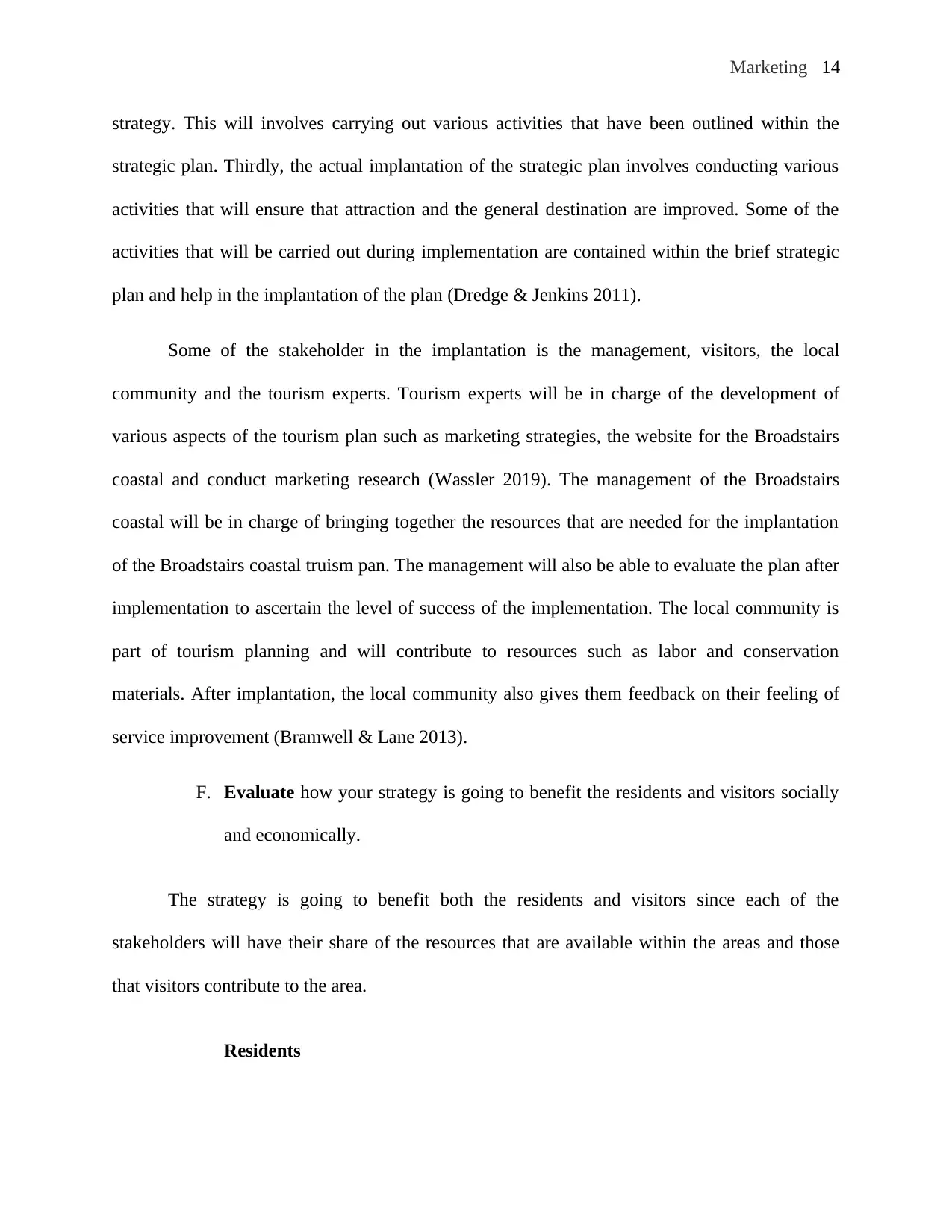
Marketing 14
strategy. This will involves carrying out various activities that have been outlined within the
strategic plan. Thirdly, the actual implantation of the strategic plan involves conducting various
activities that will ensure that attraction and the general destination are improved. Some of the
activities that will be carried out during implementation are contained within the brief strategic
plan and help in the implantation of the plan (Dredge & Jenkins 2011).
Some of the stakeholder in the implantation is the management, visitors, the local
community and the tourism experts. Tourism experts will be in charge of the development of
various aspects of the tourism plan such as marketing strategies, the website for the Broadstairs
coastal and conduct marketing research (Wassler 2019). The management of the Broadstairs
coastal will be in charge of bringing together the resources that are needed for the implantation
of the Broadstairs coastal truism pan. The management will also be able to evaluate the plan after
implementation to ascertain the level of success of the implementation. The local community is
part of tourism planning and will contribute to resources such as labor and conservation
materials. After implantation, the local community also gives them feedback on their feeling of
service improvement (Bramwell & Lane 2013).
F. Evaluate how your strategy is going to benefit the residents and visitors socially
and economically.
The strategy is going to benefit both the residents and visitors since each of the
stakeholders will have their share of the resources that are available within the areas and those
that visitors contribute to the area.
Residents
strategy. This will involves carrying out various activities that have been outlined within the
strategic plan. Thirdly, the actual implantation of the strategic plan involves conducting various
activities that will ensure that attraction and the general destination are improved. Some of the
activities that will be carried out during implementation are contained within the brief strategic
plan and help in the implantation of the plan (Dredge & Jenkins 2011).
Some of the stakeholder in the implantation is the management, visitors, the local
community and the tourism experts. Tourism experts will be in charge of the development of
various aspects of the tourism plan such as marketing strategies, the website for the Broadstairs
coastal and conduct marketing research (Wassler 2019). The management of the Broadstairs
coastal will be in charge of bringing together the resources that are needed for the implantation
of the Broadstairs coastal truism pan. The management will also be able to evaluate the plan after
implementation to ascertain the level of success of the implementation. The local community is
part of tourism planning and will contribute to resources such as labor and conservation
materials. After implantation, the local community also gives them feedback on their feeling of
service improvement (Bramwell & Lane 2013).
F. Evaluate how your strategy is going to benefit the residents and visitors socially
and economically.
The strategy is going to benefit both the residents and visitors since each of the
stakeholders will have their share of the resources that are available within the areas and those
that visitors contribute to the area.
Residents
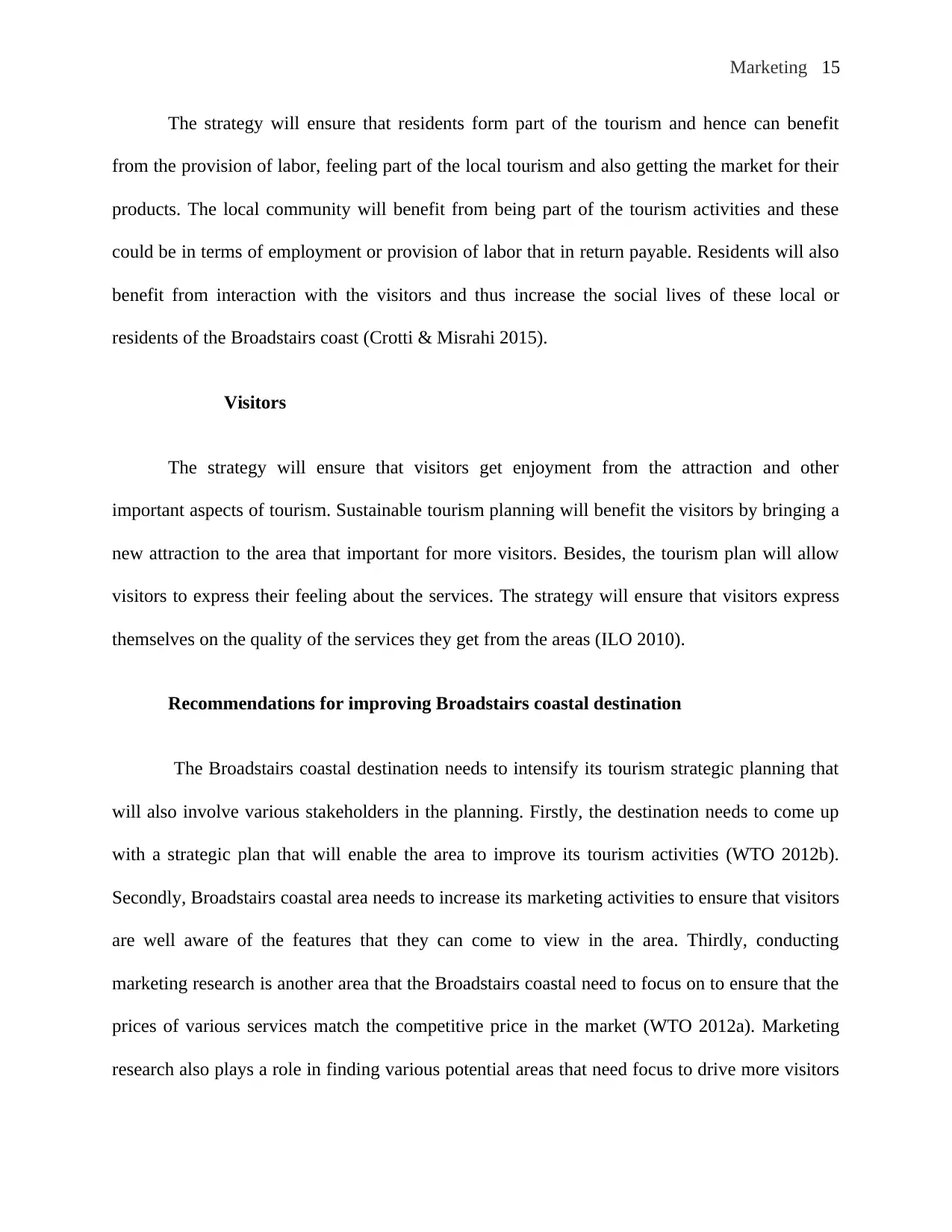
Marketing 15
The strategy will ensure that residents form part of the tourism and hence can benefit
from the provision of labor, feeling part of the local tourism and also getting the market for their
products. The local community will benefit from being part of the tourism activities and these
could be in terms of employment or provision of labor that in return payable. Residents will also
benefit from interaction with the visitors and thus increase the social lives of these local or
residents of the Broadstairs coast (Crotti & Misrahi 2015).
Visitors
The strategy will ensure that visitors get enjoyment from the attraction and other
important aspects of tourism. Sustainable tourism planning will benefit the visitors by bringing a
new attraction to the area that important for more visitors. Besides, the tourism plan will allow
visitors to express their feeling about the services. The strategy will ensure that visitors express
themselves on the quality of the services they get from the areas (ILO 2010).
Recommendations for improving Broadstairs coastal destination
The Broadstairs coastal destination needs to intensify its tourism strategic planning that
will also involve various stakeholders in the planning. Firstly, the destination needs to come up
with a strategic plan that will enable the area to improve its tourism activities (WTO 2012b).
Secondly, Broadstairs coastal area needs to increase its marketing activities to ensure that visitors
are well aware of the features that they can come to view in the area. Thirdly, conducting
marketing research is another area that the Broadstairs coastal need to focus on to ensure that the
prices of various services match the competitive price in the market (WTO 2012a). Marketing
research also plays a role in finding various potential areas that need focus to drive more visitors
The strategy will ensure that residents form part of the tourism and hence can benefit
from the provision of labor, feeling part of the local tourism and also getting the market for their
products. The local community will benefit from being part of the tourism activities and these
could be in terms of employment or provision of labor that in return payable. Residents will also
benefit from interaction with the visitors and thus increase the social lives of these local or
residents of the Broadstairs coast (Crotti & Misrahi 2015).
Visitors
The strategy will ensure that visitors get enjoyment from the attraction and other
important aspects of tourism. Sustainable tourism planning will benefit the visitors by bringing a
new attraction to the area that important for more visitors. Besides, the tourism plan will allow
visitors to express their feeling about the services. The strategy will ensure that visitors express
themselves on the quality of the services they get from the areas (ILO 2010).
Recommendations for improving Broadstairs coastal destination
The Broadstairs coastal destination needs to intensify its tourism strategic planning that
will also involve various stakeholders in the planning. Firstly, the destination needs to come up
with a strategic plan that will enable the area to improve its tourism activities (WTO 2012b).
Secondly, Broadstairs coastal area needs to increase its marketing activities to ensure that visitors
are well aware of the features that they can come to view in the area. Thirdly, conducting
marketing research is another area that the Broadstairs coastal need to focus on to ensure that the
prices of various services match the competitive price in the market (WTO 2012a). Marketing
research also plays a role in finding various potential areas that need focus to drive more visitors
You're viewing a preview
Unlock full access by subscribing today!
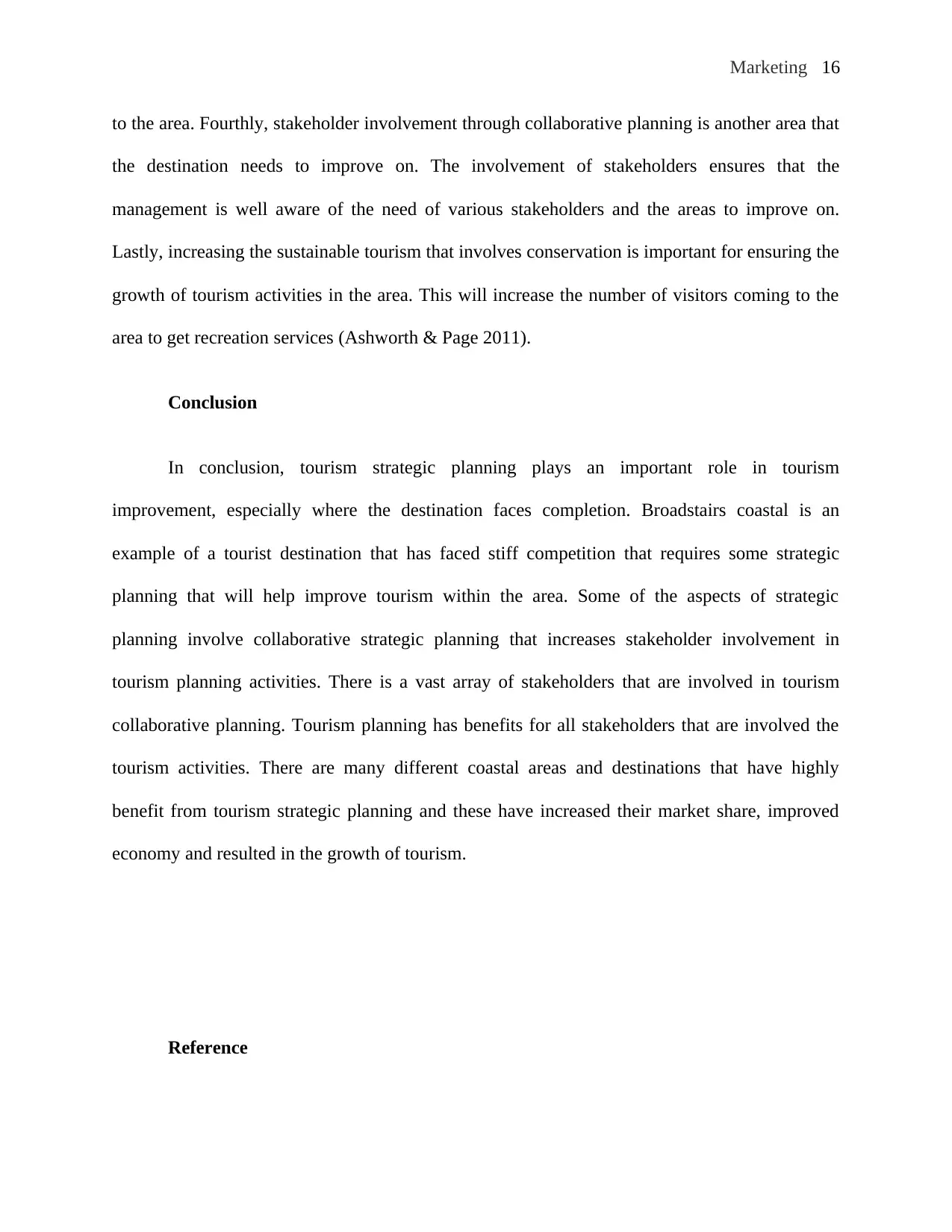
Marketing 16
to the area. Fourthly, stakeholder involvement through collaborative planning is another area that
the destination needs to improve on. The involvement of stakeholders ensures that the
management is well aware of the need of various stakeholders and the areas to improve on.
Lastly, increasing the sustainable tourism that involves conservation is important for ensuring the
growth of tourism activities in the area. This will increase the number of visitors coming to the
area to get recreation services (Ashworth & Page 2011).
Conclusion
In conclusion, tourism strategic planning plays an important role in tourism
improvement, especially where the destination faces completion. Broadstairs coastal is an
example of a tourist destination that has faced stiff competition that requires some strategic
planning that will help improve tourism within the area. Some of the aspects of strategic
planning involve collaborative strategic planning that increases stakeholder involvement in
tourism planning activities. There is a vast array of stakeholders that are involved in tourism
collaborative planning. Tourism planning has benefits for all stakeholders that are involved the
tourism activities. There are many different coastal areas and destinations that have highly
benefit from tourism strategic planning and these have increased their market share, improved
economy and resulted in the growth of tourism.
Reference
to the area. Fourthly, stakeholder involvement through collaborative planning is another area that
the destination needs to improve on. The involvement of stakeholders ensures that the
management is well aware of the need of various stakeholders and the areas to improve on.
Lastly, increasing the sustainable tourism that involves conservation is important for ensuring the
growth of tourism activities in the area. This will increase the number of visitors coming to the
area to get recreation services (Ashworth & Page 2011).
Conclusion
In conclusion, tourism strategic planning plays an important role in tourism
improvement, especially where the destination faces completion. Broadstairs coastal is an
example of a tourist destination that has faced stiff competition that requires some strategic
planning that will help improve tourism within the area. Some of the aspects of strategic
planning involve collaborative strategic planning that increases stakeholder involvement in
tourism planning activities. There is a vast array of stakeholders that are involved in tourism
collaborative planning. Tourism planning has benefits for all stakeholders that are involved the
tourism activities. There are many different coastal areas and destinations that have highly
benefit from tourism strategic planning and these have increased their market share, improved
economy and resulted in the growth of tourism.
Reference
Paraphrase This Document
Need a fresh take? Get an instant paraphrase of this document with our AI Paraphraser
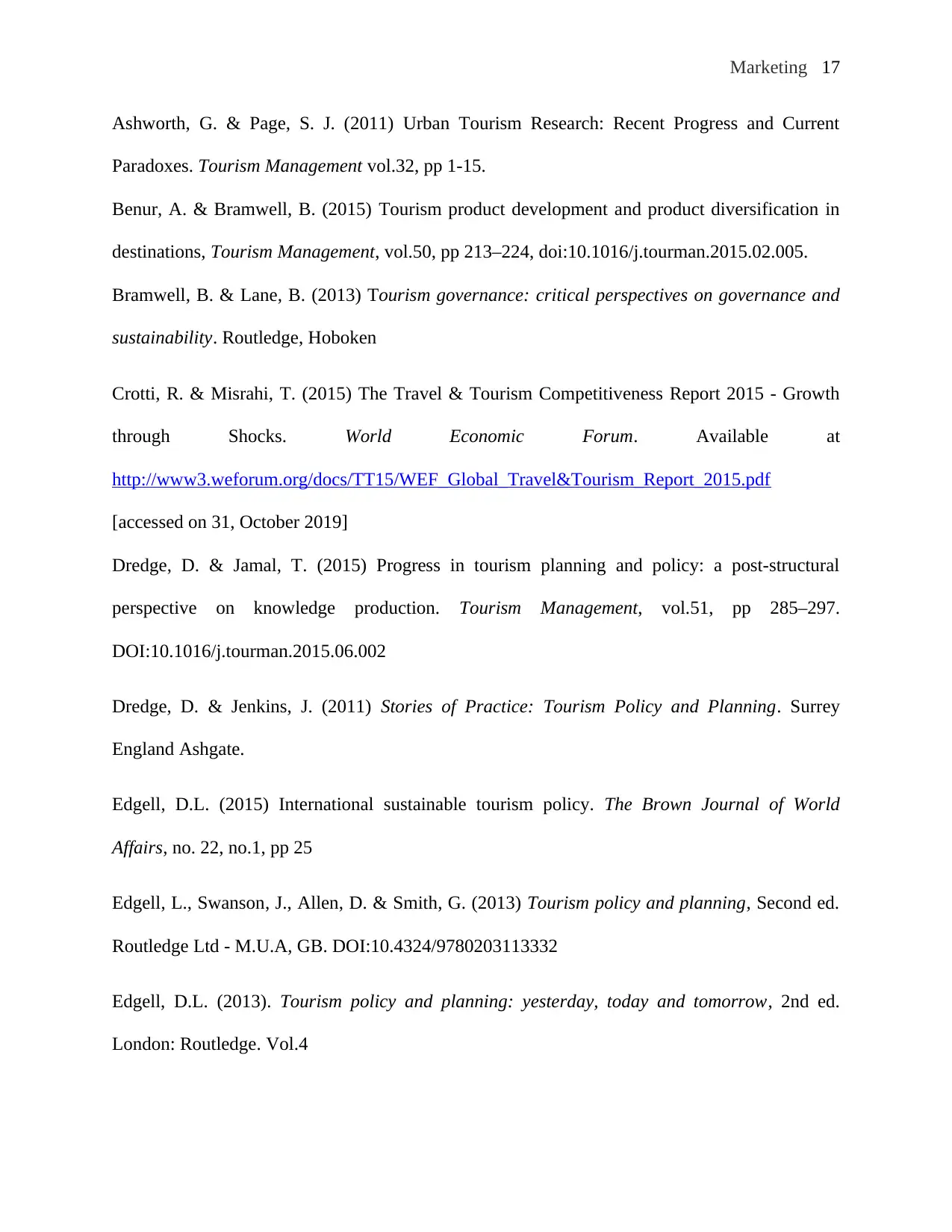
Marketing 17
Ashworth, G. & Page, S. J. (2011) Urban Tourism Research: Recent Progress and Current
Paradoxes. Tourism Management vol.32, pp 1-15.
Benur, A. & Bramwell, B. (2015) Tourism product development and product diversification in
destinations, Tourism Management, vol.50, pp 213–224, doi:10.1016/j.tourman.2015.02.005.
Bramwell, B. & Lane, B. (2013) Tourism governance: critical perspectives on governance and
sustainability. Routledge, Hoboken
Crotti, R. & Misrahi, T. (2015) The Travel & Tourism Competitiveness Report 2015 - Growth
through Shocks. World Economic Forum. Available at
http://www3.weforum.org/docs/TT15/WEF_Global_Travel&Tourism_Report_2015.pdf
[accessed on 31, October 2019]
Dredge, D. & Jamal, T. (2015) Progress in tourism planning and policy: a post-structural
perspective on knowledge production. Tourism Management, vol.51, pp 285–297.
DOI:10.1016/j.tourman.2015.06.002
Dredge, D. & Jenkins, J. (2011) Stories of Practice: Tourism Policy and Planning. Surrey
England Ashgate.
Edgell, D.L. (2015) International sustainable tourism policy. The Brown Journal of World
Affairs, no. 22, no.1, pp 25
Edgell, L., Swanson, J., Allen, D. & Smith, G. (2013) Tourism policy and planning, Second ed.
Routledge Ltd - M.U.A, GB. DOI:10.4324/9780203113332
Edgell, D.L. (2013). Tourism policy and planning: yesterday, today and tomorrow, 2nd ed.
London: Routledge. Vol.4
Ashworth, G. & Page, S. J. (2011) Urban Tourism Research: Recent Progress and Current
Paradoxes. Tourism Management vol.32, pp 1-15.
Benur, A. & Bramwell, B. (2015) Tourism product development and product diversification in
destinations, Tourism Management, vol.50, pp 213–224, doi:10.1016/j.tourman.2015.02.005.
Bramwell, B. & Lane, B. (2013) Tourism governance: critical perspectives on governance and
sustainability. Routledge, Hoboken
Crotti, R. & Misrahi, T. (2015) The Travel & Tourism Competitiveness Report 2015 - Growth
through Shocks. World Economic Forum. Available at
http://www3.weforum.org/docs/TT15/WEF_Global_Travel&Tourism_Report_2015.pdf
[accessed on 31, October 2019]
Dredge, D. & Jamal, T. (2015) Progress in tourism planning and policy: a post-structural
perspective on knowledge production. Tourism Management, vol.51, pp 285–297.
DOI:10.1016/j.tourman.2015.06.002
Dredge, D. & Jenkins, J. (2011) Stories of Practice: Tourism Policy and Planning. Surrey
England Ashgate.
Edgell, D.L. (2015) International sustainable tourism policy. The Brown Journal of World
Affairs, no. 22, no.1, pp 25
Edgell, L., Swanson, J., Allen, D. & Smith, G. (2013) Tourism policy and planning, Second ed.
Routledge Ltd - M.U.A, GB. DOI:10.4324/9780203113332
Edgell, D.L. (2013). Tourism policy and planning: yesterday, today and tomorrow, 2nd ed.
London: Routledge. Vol.4
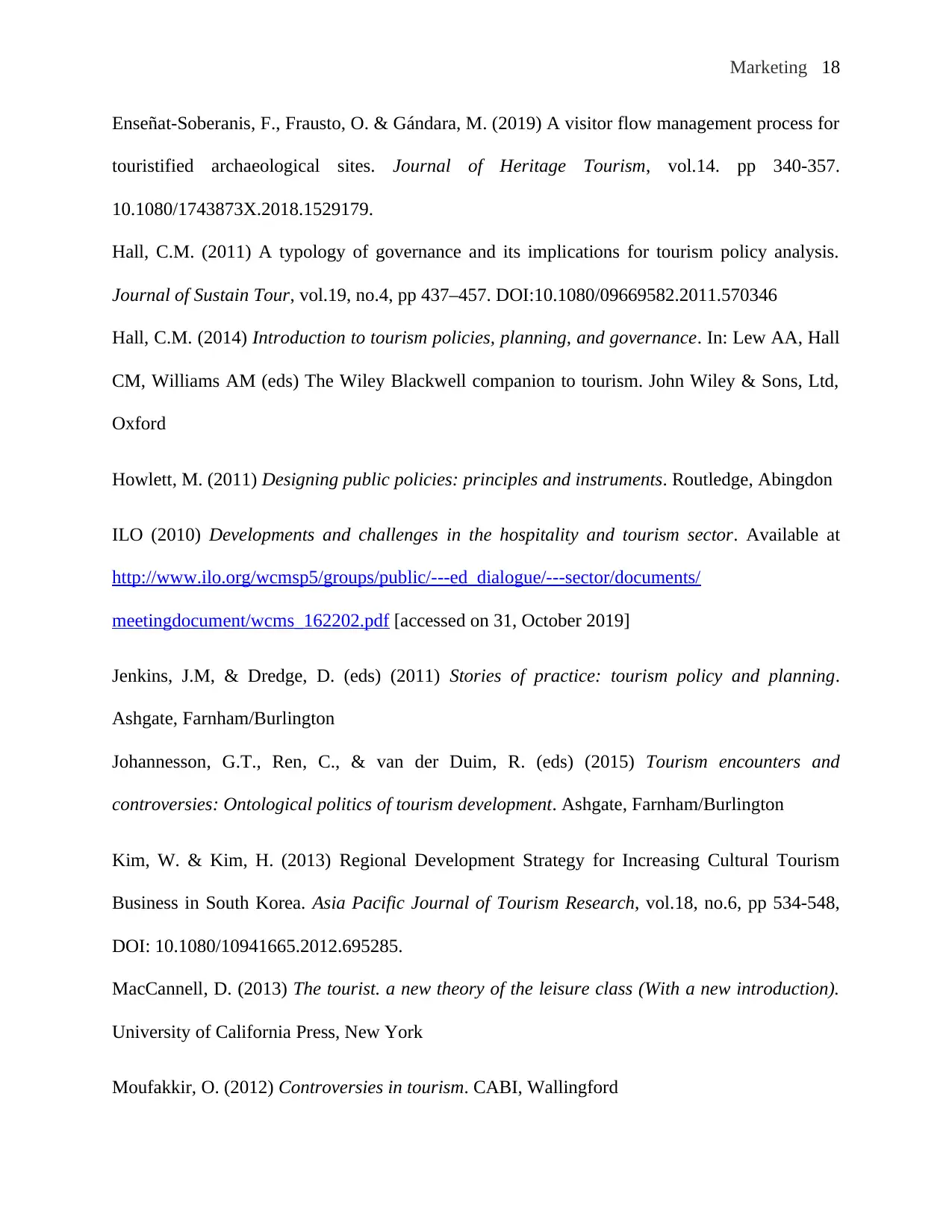
Marketing 18
Enseñat-Soberanis, F., Frausto, O. & Gándara, M. (2019) A visitor flow management process for
touristified archaeological sites. Journal of Heritage Tourism, vol.14. pp 340-357.
10.1080/1743873X.2018.1529179.
Hall, C.M. (2011) A typology of governance and its implications for tourism policy analysis.
Journal of Sustain Tour, vol.19, no.4, pp 437–457. DOI:10.1080/09669582.2011.570346
Hall, C.M. (2014) Introduction to tourism policies, planning, and governance. In: Lew AA, Hall
CM, Williams AM (eds) The Wiley Blackwell companion to tourism. John Wiley & Sons, Ltd,
Oxford
Howlett, M. (2011) Designing public policies: principles and instruments. Routledge, Abingdon
ILO (2010) Developments and challenges in the hospitality and tourism sector. Available at
http://www.ilo.org/wcmsp5/groups/public/---ed_dialogue/---sector/documents/
meetingdocument/wcms_162202.pdf [accessed on 31, October 2019]
Jenkins, J.M, & Dredge, D. (eds) (2011) Stories of practice: tourism policy and planning.
Ashgate, Farnham/Burlington
Johannesson, G.T., Ren, C., & van der Duim, R. (eds) (2015) Tourism encounters and
controversies: Ontological politics of tourism development. Ashgate, Farnham/Burlington
Kim, W. & Kim, H. (2013) Regional Development Strategy for Increasing Cultural Tourism
Business in South Korea. Asia Pacific Journal of Tourism Research, vol.18, no.6, pp 534-548,
DOI: 10.1080/10941665.2012.695285.
MacCannell, D. (2013) The tourist. a new theory of the leisure class (With a new introduction).
University of California Press, New York
Moufakkir, O. (2012) Controversies in tourism. CABI, Wallingford
Enseñat-Soberanis, F., Frausto, O. & Gándara, M. (2019) A visitor flow management process for
touristified archaeological sites. Journal of Heritage Tourism, vol.14. pp 340-357.
10.1080/1743873X.2018.1529179.
Hall, C.M. (2011) A typology of governance and its implications for tourism policy analysis.
Journal of Sustain Tour, vol.19, no.4, pp 437–457. DOI:10.1080/09669582.2011.570346
Hall, C.M. (2014) Introduction to tourism policies, planning, and governance. In: Lew AA, Hall
CM, Williams AM (eds) The Wiley Blackwell companion to tourism. John Wiley & Sons, Ltd,
Oxford
Howlett, M. (2011) Designing public policies: principles and instruments. Routledge, Abingdon
ILO (2010) Developments and challenges in the hospitality and tourism sector. Available at
http://www.ilo.org/wcmsp5/groups/public/---ed_dialogue/---sector/documents/
meetingdocument/wcms_162202.pdf [accessed on 31, October 2019]
Jenkins, J.M, & Dredge, D. (eds) (2011) Stories of practice: tourism policy and planning.
Ashgate, Farnham/Burlington
Johannesson, G.T., Ren, C., & van der Duim, R. (eds) (2015) Tourism encounters and
controversies: Ontological politics of tourism development. Ashgate, Farnham/Burlington
Kim, W. & Kim, H. (2013) Regional Development Strategy for Increasing Cultural Tourism
Business in South Korea. Asia Pacific Journal of Tourism Research, vol.18, no.6, pp 534-548,
DOI: 10.1080/10941665.2012.695285.
MacCannell, D. (2013) The tourist. a new theory of the leisure class (With a new introduction).
University of California Press, New York
Moufakkir, O. (2012) Controversies in tourism. CABI, Wallingford
You're viewing a preview
Unlock full access by subscribing today!
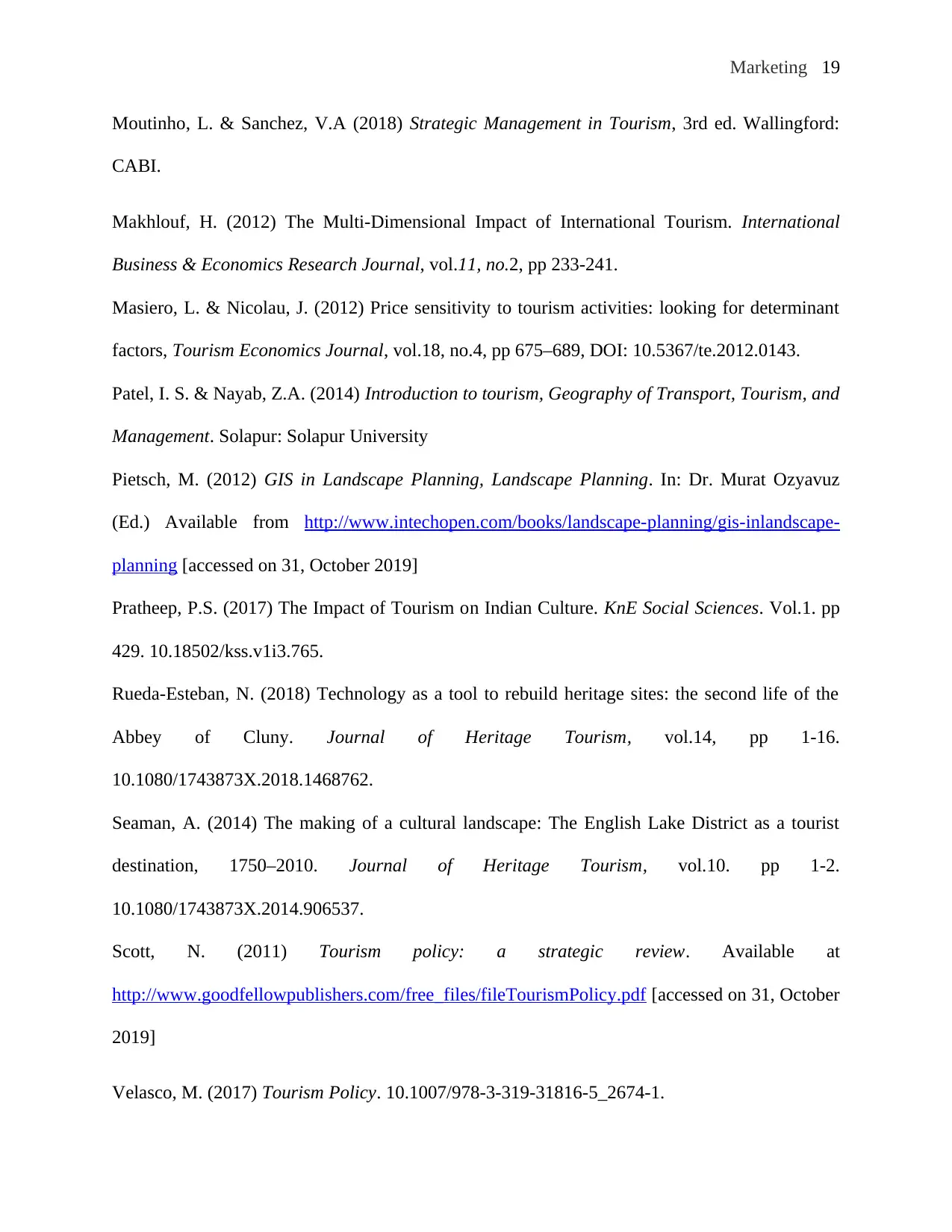
Marketing 19
Moutinho, L. & Sanchez, V.A (2018) Strategic Management in Tourism, 3rd ed. Wallingford:
CABI.
Makhlouf, H. (2012) The Multi-Dimensional Impact of International Tourism. International
Business & Economics Research Journal, vol.11, no.2, pp 233-241.
Masiero, L. & Nicolau, J. (2012) Price sensitivity to tourism activities: looking for determinant
factors, Tourism Economics Journal, vol.18, no.4, pp 675–689, DOI: 10.5367/te.2012.0143.
Patel, I. S. & Nayab, Z.A. (2014) Introduction to tourism, Geography of Transport, Tourism, and
Management. Solapur: Solapur University
Pietsch, M. (2012) GIS in Landscape Planning, Landscape Planning. In: Dr. Murat Ozyavuz
(Ed.) Available from http://www.intechopen.com/books/landscape-planning/gis-inlandscape-
planning [accessed on 31, October 2019]
Pratheep, P.S. (2017) The Impact of Tourism on Indian Culture. KnE Social Sciences. Vol.1. pp
429. 10.18502/kss.v1i3.765.
Rueda-Esteban, N. (2018) Technology as a tool to rebuild heritage sites: the second life of the
Abbey of Cluny. Journal of Heritage Tourism, vol.14, pp 1-16.
10.1080/1743873X.2018.1468762.
Seaman, A. (2014) The making of a cultural landscape: The English Lake District as a tourist
destination, 1750–2010. Journal of Heritage Tourism, vol.10. pp 1-2.
10.1080/1743873X.2014.906537.
Scott, N. (2011) Tourism policy: a strategic review. Available at
http://www.goodfellowpublishers.com/free_files/fileTourismPolicy.pdf [accessed on 31, October
2019]
Velasco, M. (2017) Tourism Policy. 10.1007/978-3-319-31816-5_2674-1.
Moutinho, L. & Sanchez, V.A (2018) Strategic Management in Tourism, 3rd ed. Wallingford:
CABI.
Makhlouf, H. (2012) The Multi-Dimensional Impact of International Tourism. International
Business & Economics Research Journal, vol.11, no.2, pp 233-241.
Masiero, L. & Nicolau, J. (2012) Price sensitivity to tourism activities: looking for determinant
factors, Tourism Economics Journal, vol.18, no.4, pp 675–689, DOI: 10.5367/te.2012.0143.
Patel, I. S. & Nayab, Z.A. (2014) Introduction to tourism, Geography of Transport, Tourism, and
Management. Solapur: Solapur University
Pietsch, M. (2012) GIS in Landscape Planning, Landscape Planning. In: Dr. Murat Ozyavuz
(Ed.) Available from http://www.intechopen.com/books/landscape-planning/gis-inlandscape-
planning [accessed on 31, October 2019]
Pratheep, P.S. (2017) The Impact of Tourism on Indian Culture. KnE Social Sciences. Vol.1. pp
429. 10.18502/kss.v1i3.765.
Rueda-Esteban, N. (2018) Technology as a tool to rebuild heritage sites: the second life of the
Abbey of Cluny. Journal of Heritage Tourism, vol.14, pp 1-16.
10.1080/1743873X.2018.1468762.
Seaman, A. (2014) The making of a cultural landscape: The English Lake District as a tourist
destination, 1750–2010. Journal of Heritage Tourism, vol.10. pp 1-2.
10.1080/1743873X.2014.906537.
Scott, N. (2011) Tourism policy: a strategic review. Available at
http://www.goodfellowpublishers.com/free_files/fileTourismPolicy.pdf [accessed on 31, October
2019]
Velasco, M. (2017) Tourism Policy. 10.1007/978-3-319-31816-5_2674-1.
Paraphrase This Document
Need a fresh take? Get an instant paraphrase of this document with our AI Paraphraser
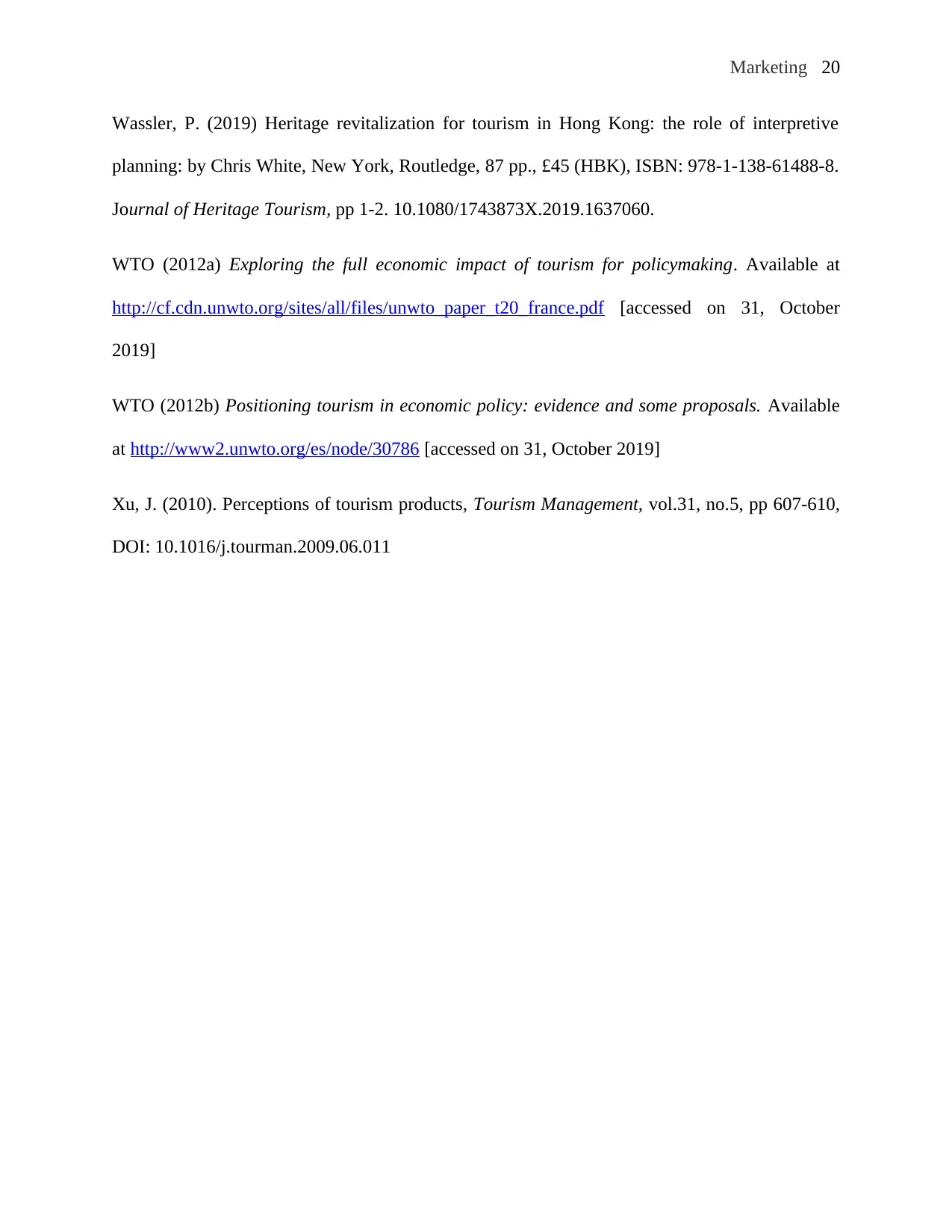
Marketing 20
Wassler, P. (2019) Heritage revitalization for tourism in Hong Kong: the role of interpretive
planning: by Chris White, New York, Routledge, 87 pp., £45 (HBK), ISBN: 978-1-138-61488-8.
Journal of Heritage Tourism, pp 1-2. 10.1080/1743873X.2019.1637060.
WTO (2012a) Exploring the full economic impact of tourism for policymaking. Available at
http://cf.cdn.unwto.org/sites/all/files/unwto_paper_t20_france.pdf [accessed on 31, October
2019]
WTO (2012b) Positioning tourism in economic policy: evidence and some proposals. Available
at http://www2.unwto.org/es/node/30786 [accessed on 31, October 2019]
Xu, J. (2010). Perceptions of tourism products, Tourism Management, vol.31, no.5, pp 607-610,
DOI: 10.1016/j.tourman.2009.06.011
Wassler, P. (2019) Heritage revitalization for tourism in Hong Kong: the role of interpretive
planning: by Chris White, New York, Routledge, 87 pp., £45 (HBK), ISBN: 978-1-138-61488-8.
Journal of Heritage Tourism, pp 1-2. 10.1080/1743873X.2019.1637060.
WTO (2012a) Exploring the full economic impact of tourism for policymaking. Available at
http://cf.cdn.unwto.org/sites/all/files/unwto_paper_t20_france.pdf [accessed on 31, October
2019]
WTO (2012b) Positioning tourism in economic policy: evidence and some proposals. Available
at http://www2.unwto.org/es/node/30786 [accessed on 31, October 2019]
Xu, J. (2010). Perceptions of tourism products, Tourism Management, vol.31, no.5, pp 607-610,
DOI: 10.1016/j.tourman.2009.06.011
1 out of 20
Related Documents
Your All-in-One AI-Powered Toolkit for Academic Success.
+13062052269
info@desklib.com
Available 24*7 on WhatsApp / Email
![[object Object]](/_next/static/media/star-bottom.7253800d.svg)
Unlock your academic potential
© 2024 | Zucol Services PVT LTD | All rights reserved.





